Back to Journal
Jennifer Ward Clarke in conversation
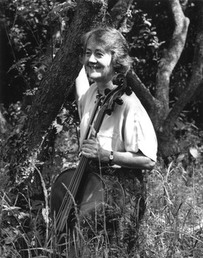
Jennifer Ward Clarke – but we can only think of her as Jenny – was a friend and colleague. She was one of the first generation of Baroque players in Britain; at the same time she was a long-term member of the groups that performed new music in this country. Her life and musical career are well described in the obituary by her colleague Duncan Druce.
We recorded this interview with Jenny on 14 July 2014, as one of a projected series of documentary interviews that we want to publish on this website. Later in the year we showed her a transcription of the recording, but she was seriously ill with cancer and we were unable to discuss it with her. After her death on 1 March this year, we found that she had made some comments on the text, which are incorporated here. We have also edited the text for fluency of expression, but otherwise it is given here very much as it was spoken. We are very grateful to Mike Foss for his permission and help in publishing this interview. The concert programmes that are shown at the end of the piece come from Jenny’s collection.
Nicolette Moonen and Robin Kinross
N: Can you remember what got you interested in gut strings and the baroque cello? What and when?
J: Oh, that comes a bit later than my first involvement in trying to discover a different style of playing. It didn’t come from the gut strings, although it became more and more evident that the instruments, the bows and the strings, teach you something themselves. Because obviously you can’t do the same sort of things and you don’t get the same kind of sound [as you do from a modern bow and metal strings]; you get a different articulation as soon as you have gut strings. But it didn’t start like that for me.
N: Tell us how it started.
J: I got drawn into it when it was beginning to go on around me. I had always loved playing bass lines, and accompanying singers. I did a bit of that in various freelance things. But it was the general influence and interest of so many different musicians from all sorts of different groups, who were making discoveries. For instance, from the point of view of hearing a new concept of sound. One very strong influence was going to hear Musica Reservata, Michael Morrow’s group.1 Well, it was not just his group. They had their first big public concert in the Queen Elizabeth Hall [in 1967], and it was a complete revelation, from the point of view of sound and new sounds. And the singing with it …
N: Can you remember what they played? Was it medieval music?
J: I would guess that there was some. There were rebecs certainly. David Munrow (who often played with the group) had all these amazing old things that he blew on – I don’t know what they were called. And the other interesting thing was the singers. Were you there, Robin?
R: No, I used to listen on radio and to recordings. Jantina Noorman was their great singer.
J: Yes, she was the one that absolutely knocked you back in your seat. So, that in itself was extraordinary, because it was so vital and exciting to listen to. It took one away immediately from the idea that you were always hearing the same sounds in your head.
N: Are we talking 1960s, 1950s?
J: 1960s, yes. One of the first startling, not discoveries, but experiences I had was at one of the Casals summer schools in Switzerland, which I went to three years running. Casals of course always played on uncovered gut – the top string. I’m not sure what his D string was. The first of these courses that I went to was exclusively on all the Bach Suites. It was a very strange array of cellists who got up and played in all sorts of different ways. But there was one particular one, who played the very popular C major bourrée in such a completely thoughtless way. Casals was obviously shocked by it and he didn’t really say anything, but he picked up his cello – he must have been well into his 80s by then – and simply played the whole of that bourrée in slow motion. It was just like seeing one of those nature programmes, when you see the slow motion film of a jaguar running around. You see this extraordinary rhythm and flow, and he was playing it in slow motion. I couldn’t believe my ears – what he showed up. It was my first real lesson in articulation, and hearing the different bow strokes. I was completely inspired by this. I had never heard anything like it. And I went back to my hotel room and thought: well, I will learn to do that. Of course I couldn’t, but I tried. So, that was a very vivid memory.
N: Just to take you back to your training: you had gone to [André] Navarra in Paris.
J: No, no, [Paul] Tortelier. I had two different teachers at the Royal College of Music. They both played on gut strings. Well, neither of them was still playing much, but I know that if they brought their cellos to the lessons – which they didn’t always – they had gut. But at that time – 1952 to 1956 – I was at the College and very few cellists had metal strings, because they weren’t made; or if they were they weren’t very good.
N: … which is interesting, because now we take it so for granted. But that is the middle of the twentieth century.
J: Yes. So, where was I? Musica Reservata: that was the first impression of completely new sounds.
N: What interests me is to hear how you experienced all these experiments. As you say, these are completely new sounds to you. What happened next?
J: Well, looking back I think I was extremely fortunate to be around at that time and part of the freelance world. I had so much in influence from colleagues. Another strong influence, from the point of view of playing music that was just never heard at that time, was that I did quite a lot of work with the English Chamber Orchestra. I was not a member, but I got a lot of work from them. We played in Westminster Abbey: a Cavalli Mass directed by Raymond Leppard, who was a harpsichordist.
N: He was a big name.
J: Yes, I can’t remember much about this – whether he was connected with Bob [Thurston] Dart or what. But anyway, we played this music on our music stand: the whole page was white, there wasn’t a black note on the cello bass line at all, and there were these extraordinary fat eggs with two lines either side, which were breves, not even semi-breves. I remember, there were four cellos and the other cellists were prepared to hate it, because there was nothing of interest to do.
N: It was boring for them?
J: Frightfully boring. I was the only cellist who actually said that it was lovely music, but I was reticent to show my enthusiasm; which was a bit pathetic.
Then there was Paul Steinitz. He formed his own orchestra, not with Baroque instruments, because they were still in a very rudimentary state of … well people didn’t have them. String players didn’t. Stephen Preston was a genuine pioneer, and he was certainly the first flautist in this country to get a Baroque flute and learn to play it. We had one broadcast, I think, and of course his flute was not nearly strong enough for the rest of us, the string players, because we were all on modern instruments and not even on gut strings. Kenneth Skeaping played a lot in the early groups. Paul Steinitz invited him to the rehearsal with his baroque violin, to demonstrate bow strokes.
N: So, that was Ken Skeaping who had a baroque violin. He was one of the first ones?
J: Well he was a different generation: Adam Skeaping’s father. He wasn’t playing professionally in the bands. He had probably been influenced by the Dolmetsches. I think he was a bit on the tail end of that; he was a very eccentric man.
N: Like all the Skeapings!
J: Yes. So that was another very vivid memory that I had. The thing about working with Paul Steinitz is the fact that he was the first person in England to perform Bach in German.
N: Ah, that was of course a big thing in this country.
J: Very big. The Passions were always in English and the Cantatas were practically never played. So, that was a big thing.
R: What other work were you doing at this time?
J: At this time? I got myself sucked into the contemporary music ensembles. That came about because I had come back from Paris, where I had worked with Tortelier. I had no work really. If I was lucky I picked up some freelance stuff. I didn’t know what to do. And the phone rang – it was John Carewe, who was a conductor. He had studied in Paris, I think with Boulez at the same time as Richard Rodney Bennett. He rang me up out of the blue and said that he was directing a group at Dartington (this was my first connection with Dartington) and they were giving a concert there – not giving a course, but giving a concert – and he couldn’t find a cellist who was prepared to play this stuff. I would have taken anything at the time. I had no idea what I was in for. So I said: ‘Of course I will come.’ That was my first baptism of fire: Richard Rodney Bennett and Susan Bradshaw (a very good pianist – I did a lot of work with her later). They were playing. They had a table full of nails and tin pans and cheese graters and all that sort of thing. It was hard to take all of it very seriously; but anyway that was that.
John Carewe formed the New Music Ensemble and we played all kinds of music – even Schoenberg, Webern – which was never performed at that time or only very, very rarely. We did a whole series of concerts in what was called the ‘recital room’ at the Royal Festival Hall, before the QEH and the Purcell Room were built. It was a horrible room. You couldn’t really call it a hall. It had a rather low ceiling and was very dry acoustically. It was an absolutely appalling place for music, but it was used for small recitals. We did a whole series of concerts there and we learnt Pierrot Lunaire, which as far as I know – I may not be completely accurate about this – had never been performed in Britain. Certainly it hadn’t been recorded here.
N: Can you remember who sang it?
J: Yes, it was John Carewe’s then girlfriend who was called Rosemary Phillips. I don’t know what became of her. Anyway, so we learned this and we gave what I think was the first live performance, in the Austrian Embassy. All sorts of critics and people came. It was terrifying. Norman del Mar was sitting in the front row – it was very small, you were terribly close to the audience – with a score! So we did that, and then we got invited to play it at the Edinburgh Festival, directed by Pierre Boulez.
N: Wow!
J: So, we went up there and went to the first rehearsal and this very nice youngish man came and introduced himself to us and said: ‘ ’Allo, I am Pierre Boulez.’
N: And how was that experience?
J: Terrifying. But very exciting. Later on I was actually in two different recordings of that piece, with The Fires of London and the London Sinfonietta.
N: Gosh, you know that piece well.
J: I played it more than any other one piece in my life.
N: So, were you quite unique at that time to actually enjoy doing this kind of repertoire? Was it like what you said about the cellists who were already against these notes.
J: The eggs?
N: The eggs … Was it a similar thing with the contemporary music?
J: I would say so. You had to be very daring, because the majority of what you played you had never heard. So you had no concept of what to expect. That was what was so exciting.
N: Do you think that that is what contemporary music and early music might have in common?
J: Well, it is a form of exploration. In the case of contemporary music there is nothing to guide you except the composer. Usually we were working with the person who had written the piece. But they couldn’t necessarily help you at all – certainly instrumentally. There were things that you were asked to do that you just had to find out how to do, leaping about all over the place.
So, around that time, after the New Music Ensemble, there was Alan Hacker, the clarinetist. He was a very big influence in my life. He was a great explorer who was very disabled, in a wheelchair. A very remarkable man. He started the group The Fires of London, initially with Harry Birtwistle, and then they invited Max [Peter Maxwell Davies] to join as well. It was called The Pierrot Players at that stage. Because there was no other regular group like that, we were the people who performed all these things. There wasn’t really any competition until the London Sinfonietta was founded. And I think, because they knew that I was already doing a lot, I was invited to be the cellist in the London Sinfonietta as well.
N: So, that’s another parallel with the early music, that there is a pool of players who can do these sorts of things and then they end up doing everything.
J: Yes, for a while. And we got invited all over Europe and Eastern Europe as well. Particularly with The Pierrot Players and The Fires of London. Contemporary music festivals were springing up, so we were always invited all over the place. We were invited by Lutoslawski to perform in Poland when it was still behind the Iron Curtain. We went to what was then Yugoslavia and Czechoslovakia.
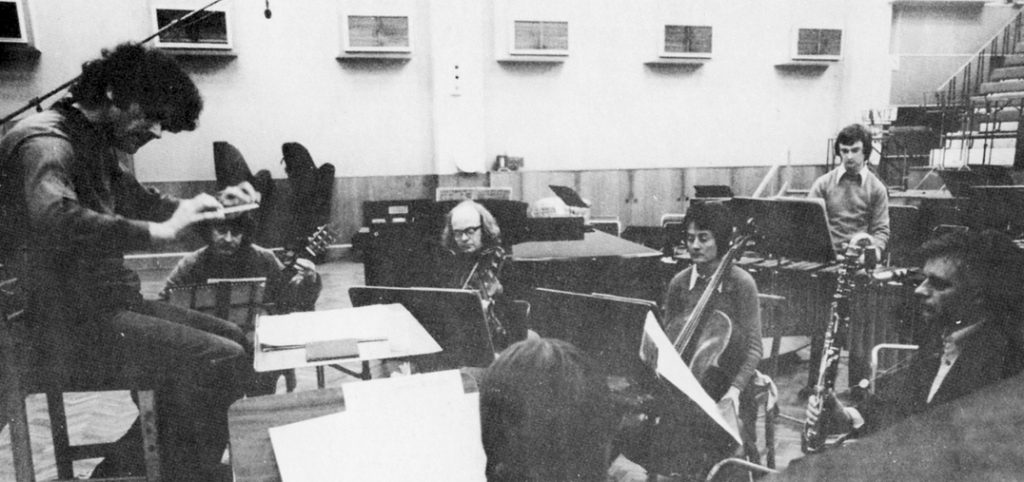
The Fires of London in rehearsal, from the programme booklet of their Australian tour in March 1974 (including Peter Maxwell Davies [conductor], Duncan Druce [violin], Jenny Ward Clarke [cello])
What was exciting then is that we were doing first performances under the direction of the composer. So we worked with an extraordinary number of composers. It was very challenging. One of the most challenging was Boulez. I actually found his music impossible. I just couldn’t get along with it or understand how to play it really.
N: Was he any help in that?
J: Not really. And Harry Birtwistle – his music was very difficult. I mean: difficult to know what to do on the instrument. I remember in one of the things he wrote, he was there, not conducting, but just listening. I asked him: ‘Harry, what do you expect to hear in these bars, because I don’t know how to begin.’ [ Imitates his voice ] ‘Oh, I don’t know.’
N: Well that was reassuring.
J: He was like that. He told me once that as a young boy he always had these extraordinary sounds in his head and he didn’t know how to get them out, how to put it onto paper. But he heard it.
N: That is the interesting thing, that musical notation is so approximate.
J: Exactly.
N: And that’s another thing in which there is a big parallel.
J: Yes, yes. I think it was from playing contemporary music that I realized that what we have on the page from early music, Baroque music, is very limited. Unless you understand more what it was like for a contemporary you could only just brush the surface of what was there.
N: You have now explained very, very well what the parallels are.
J: It was one thing to be working with the composers, but the fact is that contemporary music is absolutely littered with instructions. So, from that point of view it was completely different from early music.
N: But contemporary music is littered with instructions because the notation cannot do it on its own
J: Yes, and because it wasn’t based on rules of any kind. It was almost entirely breaking all the rules. And trying to find different sounds.
Looking back, one sees that it is all passed down from one person to another; there are very few people who really make discoveries, I reckon. Like most of us, I was just sucking up what everyone else was doing and being influenced by colleagues – some much more than others, of course. One person who taught me an extraordinary amount, very near the beginning, was Jill Severs. Do you know that name?
N: The harpsichord player.
J: Yes.
N: Lisa Cochrane’s mother.
J: That’s right. She had been to the summer course in Sienna.
N: Yes, where my parents met, and my mother studied with the same harpsichord player.
J: Really? [Ruggero] Gerlin. Gerlin was one of the last pupils of Wanda Landowska. He was there in Sienna along with Jill and Kenneth Gilbert. And incidentally a very young John Williams, the guitarist. He was still a child really. Segovia was probably teaching there. But, I was introduced to Jill by Tess Miller, the oboist.
N: Emma Skeaping’s mother.
J: That’s right. She was absolutely wonderful. She was a very inspired musician and player. We formed a trio which we called The Boismortier Trio, because the first piece we ever really worked on was by him. And Tess, of course, was always on a modern oboe, so the harpsichord was at modern pitch and I was anyway on an ordinary cello with covered strings. It was all to do with working with the articulation of the harpsichord, which was also a revelation.
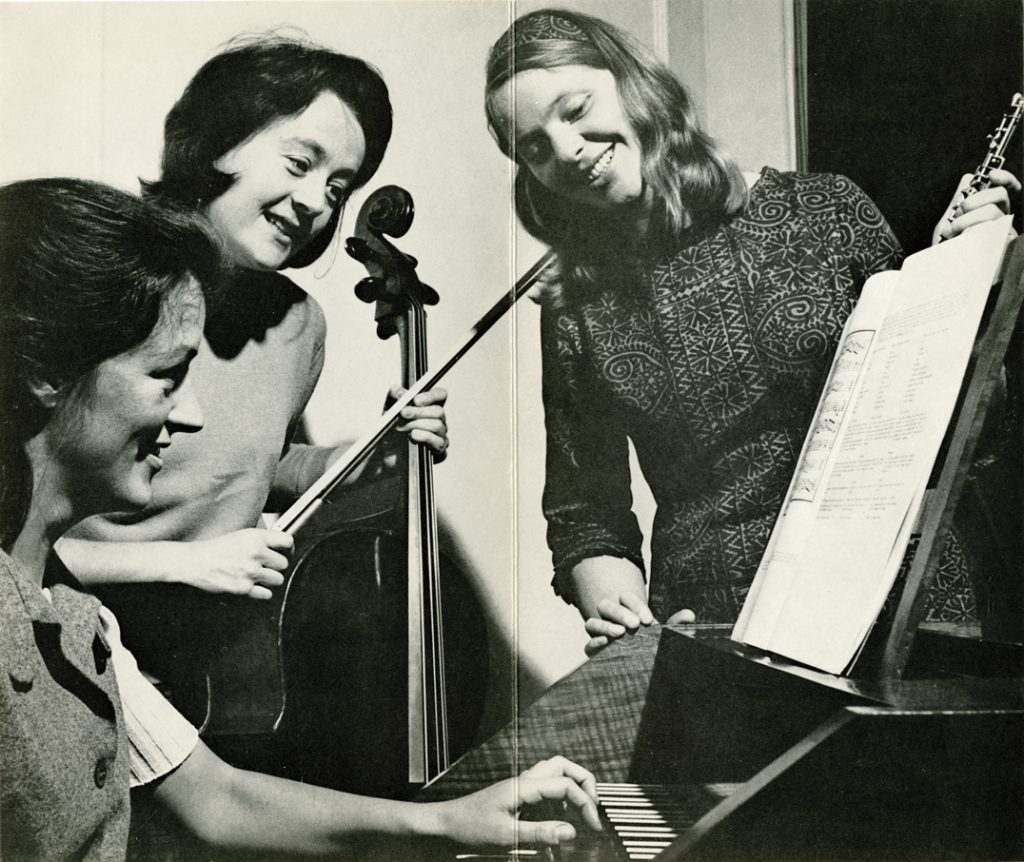
The Boismortier Trio (c. 1967): Jill Severs, Jenny Ward Clarke, Tess Miller
N: What kind of harpsichord was Jill using at the time? Was it one of those modern harpsichords or was it a copy of an old one?
J: I think it was a copy of an old one.
N: So, she was one of the first people to get one.
J: Now that was interesting – it was because of Maurice Cochrane, Jill’s husband, and through Jill and her friendship with Kenneth Gilbert. Kenneth was coming over to play in England and he had a copy made by [William] Dowd, I think made in America. Because Kenneth was coming and going, Maurice came up with this brilliant idea of offering to Kenneth that he would house the harpsichord and look after it and keep it tuned and in playing order, if Kenneth didn’t mind Jill using it.
N: Good deal!
J: It was a terrific deal. So, we worked on that instrument. I had played with people playing Gobles [Robert Goble] and, you know, all those hefty, bulky instruments. I had sometimes even played with [William] De Blaise harpsichords. They were like plastic toys. Absolutely ghastly: De Blaise and there was one other one, which I can’t remember now. They should never have been allowed to be played really.
N: They were a joke, those instruments.
J: So, this was a revelation. Jill told me … well, I listened. She taught Tess a lot about ornamentation and such things. We played very unauthentically. We played a lot of the Pièces de clavecin en concert (Rameau). So, I was way up – it is supposed to be played on gamba.
N: Tough for cello!
J: It was quite a challenge. And we broadcast quite a lot, actually: that sort of repertoire. Quite a lot of people commented that, first of all, they had never heard those pieces before; and then, what lovely music it was, and how different it sounded. So, I suppose that was quite a surprise.
N: So you yourself were exploring different ways of articulation and phrasing.
J: Yes, yes. Other musicians were doing the same – notably Trevor Pinnock. I think it was through this connection that I was asked to be principal cello with Steinitz when he formed his own group. He always used to work with the English Chamber Orchestra. He did an annual Passion, usually in St Bartholomew the Great [West Smithfield]. But it was always with the English Chamber Orchestra and he didn’t like the way they played Bach. So Steinitz formed his own group and, through Adam Skeaping, because I knew him through Tess, I became the continuo cellist for this group. I learned a lot there from working with some wonderful singers. I played continuo for different evangelists, all sorts of wonderful tenors.
R: English singers?
J: Yes. The one who stood out above any of the others was Wilfred Brown. He was the most remarkable.
N: I have never heard of him
J: Well, one day I will play you a recording I have got, not doing Baroque. He was quite outstanding, I thought. I did the evangelist with him a few times.
Another big influence was: one time when I was with The Fires of London in Holland in a record shop, I think in Amsterdam, and they had on in the background a cello. I think it would have been Boccherini –
N: Oh, Bijlsma!
J: And I heard this and I thought: ‘Oooh, that’s how I want to play!’
N: Bijlsma and Boccherini go together
J: Absolutely. Again, a complete revelation. I went to ask them who it was –
N: So you bought the record. The good old days of record shops.
J: I can’t actually remember whether I bought it or not. But anyway, that was remarkable.
And then of course the Kuykens. They came over and did a weekend at Duns Tew [in Oxfordshire]: the place where Rubio lived and made his harpsichords. That was a weekend course. I went with Jill Severs and Maurice Cochrane and one or two other people and so we were learning, hearing them teach.
N: Had you met Jaap Schröder by then?
J: No, I didn’t meet Jaap for a long time. Much later.
N: Because in Holland he was active before the Kuykens.
J: I know that now. I don’t think he came to England.
N: He did come to England a lot while I was a student with him, because he led for Chris Hogwood – all the Mozart Symphonies.
R: That’s a bit later on [1977–83].
J: Yes, that was later. Chris Hogwood, actually, wasn’t the first person to do that repertoire. It was Alan Hacker. There is another group, which Alan invited me to play in: The Music Party, doing Classical music. [Founded by Alan Hacker in 1972.]
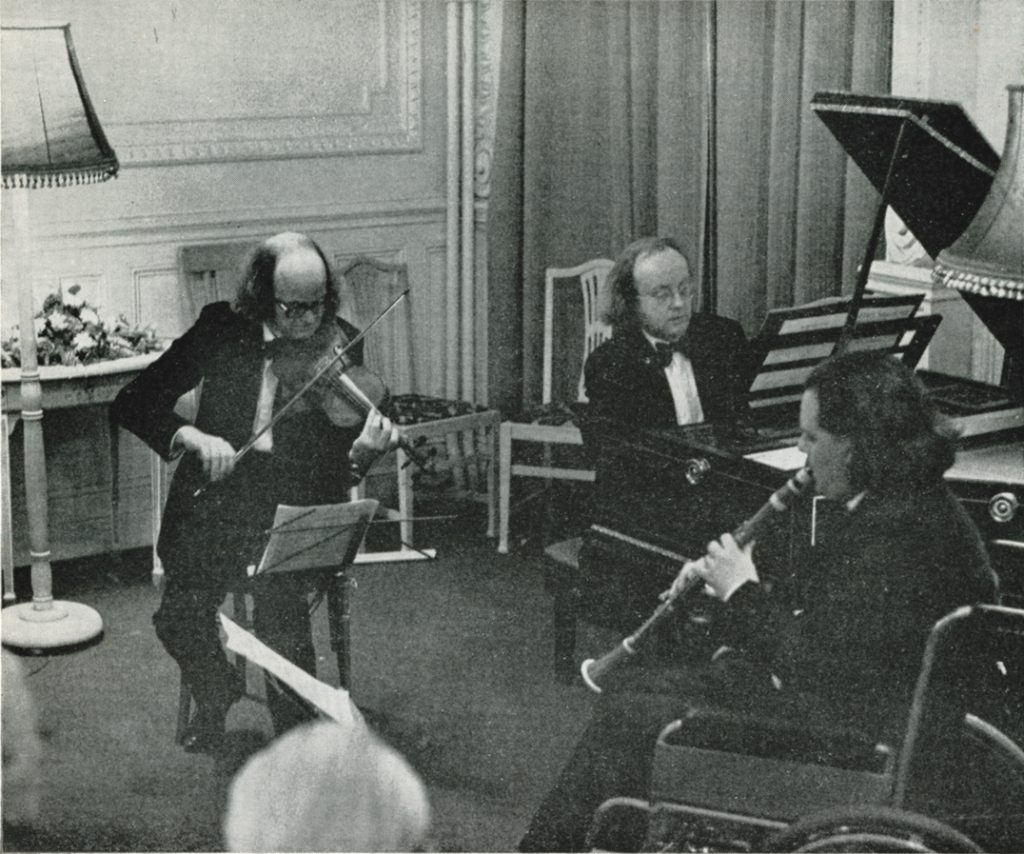
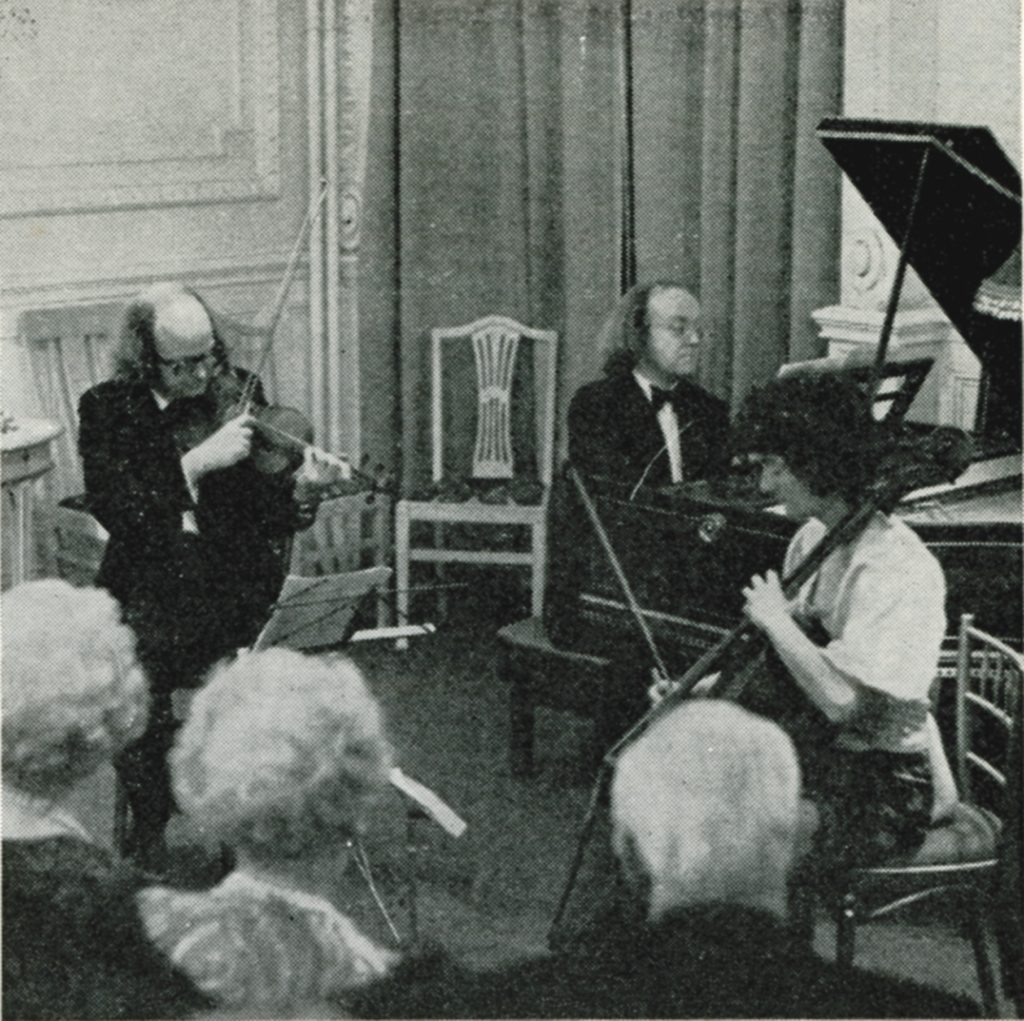
The Music Party (Duncan Druce, Stephen Plaistow, Alan Hacker, Jenny Ward Clarke) playing a ‘Music on the Mall’ concert, 17 Carlton House Terrace, 6 February 1973
We made the first recordings of Classical music on period instruments and by that time it was on gut strings only.
N: I still want to hear about that – when you went over to gut strings and a different bow, and how that was.
J: I was often playing tuned down on my so-called modern cello, which eventually I had operated on by Dietrich Kessler. But I was looking out for another instrument that I could use permanently with gut strings, and it came up. Did you ever know Gil Solomon? He was American –
N: I know the name but I never met him.
J: He was another eccentric. I got to know him. He was a very good luthier – well, restorer – and he came across this English cello. I don’t know what it was; it had had a lot of damage, but had a very sweet sound. I bought it for almost nothing, and kept that with gut strings, and without an endpin.
N: Yes, because that is also a big change
J: Yes, yes.
N: Especially for somebody who is not that tall.
J: English instruments tend to be on the small side. So I used that for Baroque and for early Classical – so that was with The Music Party.
N: Where did you find a bow? Because that was quite a challenge.
J: It was. I think through Dietrich Kessler, who was still with us, in Soho. And there was a Swiss maker who was one of the first ones – I can’t remember his name – who I got a bow from, but I think it was more of a Baroque bow really. But it was definitely through Dietrich Kessler that I got a different bow. And then through Percy Bryant. He was another … talk about eccentric! He had been in the mainstream with one of the music shops, I think. But he was considered to be one of the best makers. He lived in a sort of shack outside Brighton on the edge of the Downs and he was retired, but he still made bows. It was through Kessler and Jane Ryan, his wife, who said: ‘You must go down and see him, but you have to take your own wood.’ That was a challenge!
R: You mean for the bow?
J: Yes, you had to bring your own wood. And with Liz Wilcock, who wanted one as well, we found out about a wood timber merchant in the East End [of London], who either had or would import – I think Kessler must have tipped us off about that. And so he brought out a few raw pieces of snake wood. He said: ‘Well, take your pick.’ But we didn’t know what to choose. How could we possibly tell? So we each took a hunk and, when we got down there, we were told, Percy Bryant might not even see you. He is very moody and could be quite rude and difficult. Luckily Liz was a great charmer and he was obviously completely taken up with her. He sat down at the table with a torch on his forehead, to look, and a piece of white chalk. He looked at it. He looked quite cross the whole time and he started making rather angry marks on the wood, sort of crosses. We didn’t know what this meant, but he said: ‘That’s where it’s got the shakes.’ That was where it had a tiny little crack and he wouldn’t touch that. Anyway, he wouldn’t touch my piece. He said it wasn’t good enough. He said: ‘You must go back and get some more.’ So we said: ‘How on earth? We can’t choose.’ He said: ‘Well, you will have to ask this timber merchant if you can take a whole armful on the condition that you bring back what you don’t use, and I will choose.’ So, we did that and went down again and I had two bows copied by him from not a very good model, I would say. An original that belonged to Amaryllis Fleming. She was an illegitimate daughter of the painter Augustus John. And she was a very glamorous lady who had made a name for herself playing concertos – and she was good. She wasn’t outstanding, but she was good and glamorous. She had lived for a long time with a collector of instruments and bows. He had died and she had inherited this whole collection of amazing original bows. And Bryant copied one of those. I used that for a long time for Baroque and had a spare one that I sold to a student. He made one for Jane Ryan as well. So, that was the way I got my first copied Baroque bow.
N: So you had a Baroque bow and cello. What did you feel at the beginning?
J: It was a challenge really to know how to draw the sound, because I had never had a teacher. I never had a Baroque lesson in my life.
N: So you had a sound in your head that you tried to find?
J: Yes. And I expect it sounded awful to start with, because you have to learn to pull the bow rather than press. To do it in that way and not to attack. Well, if you attacked, of course you got a pretty horrible result. So you learned not to do that. But you also had to learn in relation to the bridge, where you have the best sound. I had learned a fair amount of that from Tortelier: how important it is to use different parts of the string, which I think not many modern students do.
N: Do they play all at the same spot?
J: Pretty much. In my experience, the ones at the Academy [Royal Academy of Music] who came for second study on Baroque cello had no idea, it seemed to me, of the difference between playing fairly near the bridge and far away from it.
N: How surprising.
J: Yes, I know.
N: For us violinists it is hard enough, because we can’t really see it. But cellists can see where they bow.
J: Yes, but they don’t look.
N: They don’t explore it … and there is a much bigger field to play with on a cello.
J: Well, on a Baroque cello particularly, it is huge. And usually the fault lies because they gauge it by the distance from the finger board. So they are playing in a very slack part of the string most of the time, when they start.
N: So, they are too high up; it sounds weedy.
J: Awful. Thin. So, yes, I suppose I had to discover an awful lot of things just from working with violinists –
N: But the violinists were also experimenting
J: We were all, yes. Another person who taught me a great deal about articulation was Andrew Parrott.
N: Ah, he would, yes.
J: I worked with him when he founded his Taverner Consort – I was his continuo cellist for that. He worked with words. And I think that some of that came probably from Musica Reservata, because their musicians copied the singers initially. It wasn’t the other way round. And singers sing with words and syllables. And with Andrew it was absolutely paramount that you tried to make with your bow the sound of the words. So, if it was Allelujah, straight away you understand the inflection. And he was wonderful with the singers. I still think he is one of the best musicians, one of the most interesting I have worked with.
So, you see, that was all very lucky. But you were picking things up from all around, from all kinds of people, from singers – especially with recitative. Somebody who is singing the evangelist is going to sing the words with the greatest clarity. Not that you are aping the singers, but in that case you really have to think about single bow strokes. Are they fast, are they slow?
It is another thing that I don’t think contemporary, modern players are aware of – the differences in how a bow begins a note. It either starts fast or gradually. I found I used the concept of the alphabet, of the consonant sounds, all the time with the bow. Whether it was a ‘t’ or a ‘w’ or a ‘b’, or whatever, because they all require such a different front. But that I think came not so much from other string players but from singers.
N: This is the whole notion of playing in a rhetorical way. The word is used a lot.
J: Yes. The influences came from so many different directions, also listening to recordings from the Continent.
N: Were you aware of people like Harnoncourt at that time, through recordings?
J: Well, at some stage definitely, yes. Because the big people on the Continent for us were Harnoncourt and Leonhardt.
J: Yes.
R: Because he is a cellist, isn’t he? When did he stop playing cello? Did you consider him as a cellist or as a director?
J: I don’t think he is known as a cellist really.
N: But in his first recordings he played the cello.
J: Yes.
N: And the gamba. But I suppose when he started this was also important: he did start playing the cello in a very different way and he was working with string players and telling them what to do.
J: Well, I have certainly listened to a lot of his Cantata recordings.
R: This is all really the early 1970s would you say?
J: I think probably, yes, it was during the 1970s, and the time when groups were beginning to form. Actually The Music Party was a very big influence on me. Alan Hacker was playing there with Richard Burnett – do you know who I mean?
N: I know that name.
J: He is an eccentric if you ever needed to know one.
N: A long list of eccentrics!
J: Absolutely. But he collected old pianos while they were still available. He could go around to sales and pick them up for £100, because nobody else wanted them. And then eventually he set up the wonderful museum at Finchcocks in Kent.
N: He is still there, still alive!
J: Just. The first experience of working with Richard Burnett was with Alan Hacker. Richard had this absolutely beautiful Graf piano, an original. At that time he lived in a very small place in Pimlico and he couldn’t house this instrument. So, it was kept in Keats Grove, in Hampstead, and we went up there to rehearse. I had never heard anything like it. It was so beautiful and so we started working, just the three of us, with these old instruments: Richard Burnett’s original ones. They were looked after by Derek Adlam. Do you know that name? Well, he made pianos: a very, very good piano maker. When Richard Burnett bought Finchcocks and set it up, Derek Adlam was making pianos down there – copies, very fine copies. And Alan was playing on boxwood clarinets. So, that was already something quite different. It lightened up.
We did a lot of chamber music. Then it expanded and we did a recording. Peter Wadland was the producer at Decca – he did all the Mozart Symphonies with Jaap Schröder later. He was very interested in this group and wanted to make a recording for Decca. We were the first classical instrument players of this kind to make a recording for Decca. We made a lot of records actually. We did a recording of the Hummel clarinet quartet, which is a very good piece: clarinet and string trio. That was with Duncan Druce, who was in The Fires of London; Alan was as well – so there were three of us who were in both groups. We did many concerts too and I played a lot with period pianos. Beethoven Sonatas, Schumann, Mendelssohn – all kinds of things. We did the Beethoven Septet and the Schubert Octet with period winds. Alan eventually became a professor at York University, in the music department. He then managed to get together a symphony orchestra of Classical instruments, many of whom came up from London. Tim Mason, for instance, was one of the other cellos. Alan put on what I think is certainly the first performance in this country of a Beethoven Symphony on Classical instruments. We would be pretty horrified now to listen, because it was pretty raw. And Alan Civil, who was one of the great horn players, came up and played a Mozart concerto on a hand horn. And then later Alan Hacker came down to London and conducted Beethoven 9 in St John’s Smith Square in a charity concert for disabled people. And for Decca we did a recording of Arne overtures, in which Chris Hogwood was the harpsichord. Duncan was leading, I was principal cello, and Mike Laird was there sawing bits of his trumpet trying to get the pitch. Also Cat Mackintosh was playing: all sorts of different people and it also probably was a bit raw. But it was after that recording that Chris got together with Peter Wadland and proposed a whole lot of things. So Alan was pushed aside. But all this innovation of his was wonderful. He is a forgotten name.
N: It’s a shame
J: I know and it was very hard for him. Alan was a difficult person to work with and not good at organizing anything. He never had people around him who organized. He was very unyielding in his idealism. But he was a very big influence, I think, in all of that.
Another wonderful person: Lina Lalandi. She used to run a festival in Oxford which combined Baroque and contemporary music. I played in some of those things. She invited Xenakis to come for the first time and his music was performed in her festival.
N: Because of the Greek connection?
J: Yes.
N: And then of course she did a lot of Rameau.
J: Exactly. You could definitely call her a pioneer.
N: Indefatigable, also.
J: I worked many times with her actually. Chaotic.
N: There was a complete lack of organization.
J: Completely chaotic. But how she did it, I don’t know. She even put on Rameau operas in Covent Garden.
N: She put things on in Athens.
J: Yes, and Versailles. We played in Versailles, at the Royal Theatre there. You see there were all these people around who were doing new things.
N: They were visionaries.
J: Yes. In contemporary music, there was the London Sinfonietta. It was extraordinary working with all these composers.
R: Who was the driving force at the beginning of the London Sinfonietta?
J: It was group of people from Cambridge: David Atherton, who was the conductor, and the clarinetist Tony Pay, and Nicholas Snowman, who was the great entrepreneur figure there. And then another man who just did administration: I can’t remember his name now.
R: They were all outsiders in some way.
J: And Tony Pay, for instance, didn’t read music at Cambridge: he read maths. It was interesting that it was around about that time that there were players who were coming from universities to study at the music colleges or to come into the profession. When I first went to the College they weren’t university trained people. Definitely not. So, there were people coming in with lots of ideas and lots of musical knowledge and background, and who had the organizing skills and interest to form their own groups. The London Sinfonietta was quite a big event in the London music scene. That was after The Pierrot Players, which changed its name when Harry Birtwistle left and became The Fires of London.
N: You kept doing both for a long time, alongside each other?
J: Yes. And then John Eliot Gardiner started up, but not on Baroque instruments.
N: Did you play for Jiggy?
J: Yes, I was his first continuo cellist.
N: How long did you last?
J: A few years [ laughs ]. The last thing I think I did with him was the Monteverdi Vespers, with a big group. It was recorded for an LP.
N: Were you still with him when he started playing on Baroque instruments, or did you leave before that time?
J: No, I think I had been sacked by then. Because I know that the Vespers was done with a whole violin section. I have surprisingly rather dim memories of that. Robert Tear was one of the tenors. And I did a lot of work with Roger Norrington before he founded the London Classical Players. He had his choir, the Schütz Choir, and I did some wonderful music with him, when he only used a continuo group. So, I had another extraordinary influence there.
R: It sounds as though you were very busy.
N: I was just going to say: what did your diaries look like in those days?
J: Yes, and I was doing some teaching as well. I never stopped.
N: All that repertoire, especially the contemporary, you would have had to practise like mad.
J: Yes, I suppose I was very lucky. Extremely busy.
N: And that brings me to my next question: when did you start teaching?
J: Before I left the College. I took a job in my last year at the College, because I was very conscious of the fact that when I left I needed to earn a living. I was offered a one-day-a-week teaching job in Chelmsford in Essex, at two grammar schools. That was rock bottom and I did quite a lot of that. I taught in Ealing in a school. I used to go out to East Ham for an hour a week, and I did a bit down in Wallington. And another bit in Camberwell – but they were sort of half days. It was not all perhaps at the same time. I was driving all over the place: I had a little Morris Minor, I went everywhere in that. And I had a few individual pupils – that came a bit later.
N: And when did you start teaching Baroque? You were the one teacher in London.
J: With absolutely no qualifications whatever. I was self-taught as far as that went. I didn’t really know how to teach it. It was very difficult. I was all very woolly.
N: I am a bit sceptical when you say that
J: I was very nervous about teaching it, because I didn’t have enough basic understanding of what it was I was teaching, I think. It was Paul Steinitz who said to the Academy that he thought it was appalling that there was no hint of influence of Baroque there at the time. He also got Simon Standage to teach at the Academy then.
N: What was it like when you started there?
J: I don’t think I had any first-study students. I just had to do some coaching and take classes. It is such a long time ago … But certainly I felt I was learning through teaching, as much as I was trying to teach the students. They were teaching me by what they didn’t understand or couldn’t do. And I had to think of a way to describe it to them. I could teach a lot about the music, technically. But musically – certainly about phrasing – they didn’t have a clue. There was such a very worrying lack of concept of what is a phrase, and any idea of harmonic progression. That has changed quite a bit, but initially there was no way of understanding phrase lengths.
N: What did you feel about what they were taught?
J: Well, the thing is that there is very little Baroque repertoire that is taught by the modern teachers. On the cello the only music that they all do learn is the Bach Suites, because of course all string players study those, and a few Vivaldi Sonatas possibly. And other than that I don’t think they know any of the repertoire. And nor did I. I had to discover all that as well: find facsimiles; make endless photocopies and stick them together for the students, because there was nothing available in print. They didn’t even learn Boccherini. Well, they still don’t.
N: It is not part of the normal curriculum, is it?
J: No.
N: Which is extraordinary when you think that Boccherini was an important cellist.
J: Yes, he wrote an extraordinary number of sonatas. Most of them are not available in print.
N: Still not. Although there is more now.
J: There are Italian editions which are difficult to come by. But there are a huge amount of publications now – of things you have never heard of. I relied on things I had to discover myself. I remember getting hold of the Gabrieli ricercars. I had never seen or heard that music from anybody. The only thing available was a modern edition, which was OK. I remember looking at the book and thinking: ‘How do you approach this? What do I do? How can this be music? Only just through exploring it.’ Then eventually I came across Anner Bijlsma’s recording of all of them. That was very interesting. Yes, nobody had heard of these. So, you had to rely on your own discoveries very much, and then somehow you would approach it. In a printed form it looks so square.
N: We go back to where we were. Notation is very approximate.
J: Yes.
N: It is a code language. Would you say that the students that came to you hadn’t learned how to decode?
J: Oh no, no. What I do feel about the modern players is that there is so little understanding of the significance of a slur. And because there is such a way of using the bow with a lot of modern players. You can see it. If you watch the symphony orchestras on TV you see them: they go within a slur [ mimicks a pulsating movement ].
N: Portato, portato, portato.
J: There are very few players who play with a true slur. That is something quite different. Completely different. And then you look at Leopold Mozart, and all of that, and you realize how much it affects the way the music flows.
I came across a recording recently of the Mozart Clarinet Quintet. The first fiddle is very musical, but without any sense of anything other than what has been heard already. That is the trouble: that you develop your approach – in most of that repertoire, if not all of it – from what you know of it already.
With the contemporary music you don’t know what the sounds are or how they relate to each other or whether the composer wants this or that, although there is always instruction on the page. Until you have tried it you don’t know what it is that is going to come out.
But to come back to this recording. It goes: [ sings the first few bars ] Now this recording goes: [ sings the same phrase without any articulation ] All completely one big slur, and not even necessarily a very beautiful use of the bow. I can’t understand how that can be. They are not that young, probably late 30s. They have heard it all already, and that’s how they play it. You have to change the slurs. But they think it just means when you turn your bow around.
N: The technique dictates the music and that is nonsense.
J: And they have learned so carefully; I mean, wonderfully. They have learned to make inaudible bow changes. And that is one of the first things I say to students: that you must realize that every single time you change the bow, then we need to hear it. Because it is there for a purpose. And that the bow changes are all like the consonants in our speech. It makes the sense of the speech: without consonants you couldn’t speak; the vowels are what carries the sound from one consonant to another. I think some people always remain Romantic players. It is in their nature.
N: What I see in teaching violin students is that playing the violin takes precedence over playing the music. There are always a few students like that. Whatever you do they remain violin players rather than musicians.
J: Yes, that’s very true.
R: One more question. About the string quartet you were in with Simon [The Salomon Quartet] – that was also working in the territory of early Classical. What was the idea of that string quartet?
J: To explore the transition from Baroque to Classical style. I had already done a lot of non-string-quartet Classical repertoire. We did do a bit of string quartet playing with The Music Party, with Duncan leading and all sorts of people from its programmes. We sometimes worked with Cat Mackintosh, Trevor Jones – it was quite a mixture. We weren’t strictly speaking of a string quartet then, we just put in a Haydn quartet occasionally in a programme. But I did quite a lot of work with the English Concert, because Tony Pleeth, the cellist, was quite often unavailable, or because he had given up flying: so unless he could drive in Europe, he wouldn’t come. So I did some of the distant tours with them. So I had worked with them quite a bit and I just longed to do that repertoire.
I can remember in the pub after a concert, I think with the English Concert, up in Rosslyn Hill Chapel [Hampstead], having a drink with Simon. I said: ‘It would be so wonderful to do Haydn quartets. Couldn’t we make a string quartet?’ He was very excited by that. At that time it was Liz Wilcock who led the seconds in the English Concert and we did a programme – Trevor Jones arranged it – down in Bradfield College, I think. It was called ‘English Concert Quartet’ or something like that. That was with Liz playing second and we decided that we wanted to continue. Liz decided she wouldn’t; she didn’t really want to be second fiddle and didn’t want to commit herself. That’s when we asked Mica. That concert in Bradfield was in 1981. So it came very much from working with the English Concert. I think Trevor Pinnock already might have done a slightly more Classical programme.
R: That seems to be the time where you were collectively getting on to early nineteenth-century music.
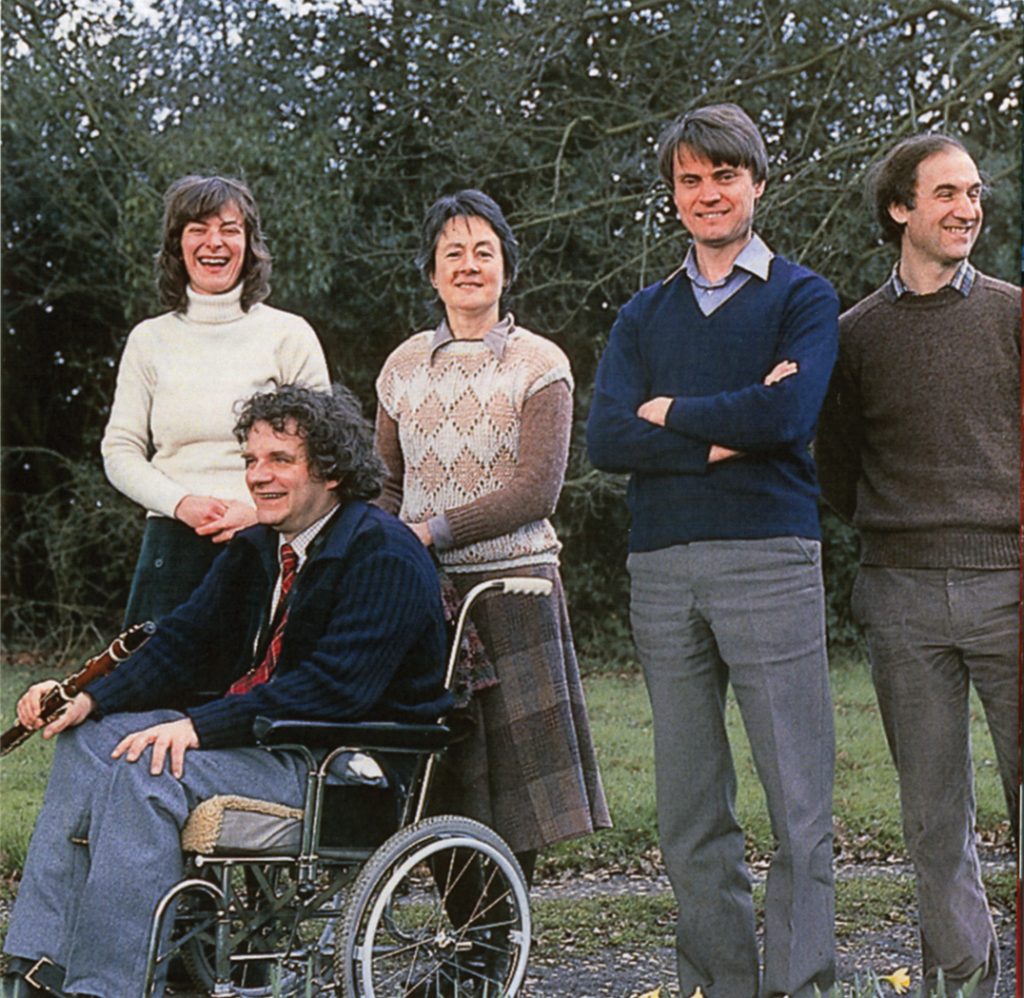
The Salomon Quartet (Mica Comberti, Jenny Ward Clarke, Simon Standage, Trevor Jones) with Alan Hacker, from the CD booklet with ‘Mozart: Clarinet Quintets on original instruments’ (Saydisc Records, 1984)
J: You see, The Music Party went way back to 1972, when it was founded. I think Alan Hacker has been very much overlooked. He was very bitter about it, actually.
N: I am not surprised. That’s the world of commerce isn’t it?
J: Yes.
N: Which I think in this country has been particularly strong. I think stronger than on the Continent.
J: Well there were record companies here, of course … they saw something new, something in an area that hadn’t been explored or presented before. That is why Peter Wadland took it up, and Chris Hogwood saw the possibilities. But then, talking of instruments, everybody still played on their Baroque instruments for this repertoire, because nobody had Classical instruments. Our first recording with the Salomon Quartet was done on Baroque instruments with different bows – we did get different bows.
R: In some ways that is better than the other way around – playing it on twentieth-century instruments.
J: Absolutely. Because one of the exciting things for us with the quartet was realizing why players of that time had to go to the luthiers and say: we can’t play these long slurs. We need more tension in the instruments.
R: So you were really acting out the process.
J: Yes. Also, because of the problems and difficulties of playing on the gut strings – high up and all that – and intonation, it made a lot of the music which, when it was written at the time was considered almost unplayable, it made it once more a great challenge to play and therefore created different kinds of intensity.
N: I find that interesting in these old recordings – to hear the effort.
J: Exactly.
N: And in a way we have lost something now that some things have become a bit too easy.
J: Absolutely. The way the instruments are set up now. I can tell watching cellists when I see them at the top and the facility they have – you couldn’t do that unless the set-up had been made much easier.
N: And the wind instruments as well. I remember being very disappointed in hearing a Mozart opera at Glyndebourne with Robin Ticciati conducting – Don Giovanni. It sounded all so smooth.
J: Age of Enlightenment?
N: Yes. And I thought: this is Don Giovanni. For that time it was very extreme music. But this was all done with a gloss.
J: Well, it is coming around again in a circle, isn’t it.
N: Yes.
J: Once you become too familiar with it, perhaps with better strings or whatever it is, and with the technique, you stop paying enough attention to things like articulation –
N: – or to the score and the extreme dynamics. This music was made to sound so normal.
J: It is over familiar. There is nothing more dangerous than familiarity, which is the case with so much of the Classical repertoire, which is played and played. People know it all – how it sounds – and so they don’t think more about it than that. I am afraid there is a whole lot of very good players, who now join all the period instrument groups. They don’t need to think about all that, because it is like ready-made meals. They don’t have to think of the ingredients. A lot of it now is extremely good. It’s not like fast food, it’s proper food. But people rely on it and they don’t know about putting in that bit of spice or that bit of something else.
N: Yes, it is a nice analogy. I feel exactly the same. I think we need another Early Music movement to shake it up again.
J: I thought that came into Trevor Pinnock’s article [in Early Music ], which I reread a couple of days ago.2 I thought that was interesting. At the end he made this observation about the danger of not exploring any more, because the exploration has been done. It’s also a bit like people who now pay a lot of money and get to the top of Mount Everest, but on the back of goodness knows what sacrifices or knowledge or equipment that is now available. In some ways, luckily, the mountain still exerts its power over human beings. But I think that to take well-worn repertoire such as – in the cello repertoire – the Bach Suites: every cellist has learned them, and there are all these different editions, and recordings to listen to. How can they come up with their own ideas? Young players need to be inspired by recordings, up to a point. I had a student once, who, whatever I suggested she learn, she went and got a recording of it
N: They all do that. It is very annoying. Or they come to a lesson and say: ‘I couldn’t get a recording of this.’ And I say: ‘Good!’ It is what you were explaining very well: trying to imagine something, searching for something, thinking for yourself. It’s very different from trying to copy something.
J: And that was the very exciting and challenging thing about being in these contemporary groups.
R: How long did that go on for you?
J: Well, I was in the London Sinfonietta for ten years, and The Fires of London also for ten years. Then four of us out of the group of seven in The Fires of London left at the same time, because we felt we were rather going around in circles. When we went to festivals: they all wanted ‘Eight Songs for a Mad King’, and that wore thin after ten years – a good long time. With the Sinfonietta, it remained challenging, because it was an expandable group, it depended on the repertoire. But the main reason I left that group was exhaustion, because after I had had my daughter Kate: I couldn’t keep all that up, and I didn’t want to. There was the touring – the Fires were also doing long distance tours. I thought it was time to stop.
N: It coincided with Kate being born.
J: Yes. When she was about two, I finally left. I realized that I just couldn’t combine this any more.
N: So, then you gravitated to doing more early music?
J: It sort of turned out that way. I left the Fires in 1976. But with the Sinfonietta, I didn’t want to leave completely, so I spoke to the artistic director and said I would like to swap places with Christopher van Kampen, who was the second cellist. I said that I would like to be number two and didn’t want to lead any more. I didn’t think it was fair to opt out of the long-distance tours and have him come in and be principal, and then have to go back to be number two; and I didn’t want to have that sort of commitment. So I went on doing quite a bit with them from time to time, but not so much. Also contemporary music is physically very exhausting.
N: And all the time for the preparation you have to put in
J: Yes.
N: To go back to the period orchestras, did you play with the OAE?
J: Yes, at the beginning. I played principal with them. And, as I have said, I played for Roger [Norrington]. I forget how many years I was with John Eliot Gardiner – maybe not that much. He turned me out – I can’t remember what year that was, but it was probably in the early 1970s. Then I played with Andrew Parrott. I think at that time there weren’t really many cellists who were interested in just playing bass lines.
N: That’s what you said at the start. They thought that was boring, and some of them still think it is boring.
J: But also, because of the work you do at the music colleges, this is not part of your training in the general run of things. You are taught to play the solo repertoire. And for a lot of cellists it is very frustrating when they are pushed down on to a bass line. I can remember at the College, in the early days when there weren’t any first studies, the students were all people who wanted to find out a bit or were curious, or were just told to come to a class. In the morning they had been having a lesson on the ‘Rococo Variations’ or something like that. I would put something in front of them which was very simple, mostly white notes – and they couldn’t be bothered. They couldn’t see the point of it. Anyone could play those. That was grade 2. And so there was a very different approach.
I remember one student ringing me up. She had gone to have lessons with some German teacher who had more or less told he that she was a hopeless case (those are my words), that she had no real basic foundation or technique, and that he would have to take her right back to the beginning, and that she would never make it in the music profession unless she got some discipline and did all this technique. She was absolutely horrified and she rang me up and said: ‘What shall I do?’ I said: ‘He is not the teacher for you.’ Not every cellist has to be what he is describing. We would be in an awful way if everyone played like that. I said: ‘You do what you do best.’ But there was this blinkered way of teaching the cello: ‘This is what you have got to be as a cellist.’ As a cellist, not as a musician.
N: It is the conservatoire way of thinking.
J: Yes. But it is changing now. At the Academy there are now a lot of the so-called modern players who are genuinely interested, I think. And in the modern symphony orchestras too.
N: But when I talk with the students at the Academy, they make it clear that it is a very small minority of students in the modern department who are interested. Most of them think it is absolute nonsense. And there is still no real collaboration.
J: No.
N: They like to pretend there is, but in practice there isn’t.
J: I heard by chance on the radio a recording of the C.P.E. Bach A minor cello concerto. I can’t remember what orchestra it was, but it was such fine cello playing and so beautifully, musically played. A modern cellist: Truls Mørk.
N: On modern violin there is Alina Abragimova. Beautiful. The Prokofiev that she has just recorded – the phrasing. I heard it on the radio, not knowing who was playing, and I was sitting up with full attention, which I don’t often do with modern violin. There are a few at the moment. Her and Julia Fischer and another one … who are amazing. And they have done Bach
J: Well, you hope there would be players like this. Just as I heard Anner Bijlsma by chance on that recording, and thought: ‘Well that’s it, that’s how I want to be able to play.’
N: I think there will always be players who do have a lot of personality, who have a different imagination and sound world and don’t just step into a tradition.
Is it time to bring this to a close? Are there other things you want to tell us?
J: I suppose that the summary would be about having had the experience playing so many first performances of something that nobody has heard before, with no chance of copying. I think that is a very big thing. I would say with all the well-known repertoire of whatever period, it is impossible to be in that position, because you have heard everything before.
N: And also your audience is never in a fresh position, because they are coming to listen to an interpretation rather than a piece.
J: Or rather the other way around. They are coming to listen to the piece, not worrying too much about the interpretation. But, yes, I can remember when I was still at school and with very little input of music-making – it was a very unmusical school – but I was given Pierre Fournier’s recording of the Dvorak concerto. It was when I heard that that I decided I wanted to be a cellist. I was already 16. I had never thought of what I was going to do when I left school. I absolutely based my performance later on what I had heard on this recording, because it was just wonderful. And I had never heard the piece before and that was it. And then later I heard other recordings of it. Then you begin to understand how many clichés there are and what people copy, and you have done it yourself. So, it’s inevitable.
Early music and new music groups in the UK
1960
Musica Reservata founded (Michael Morrow, John Beckett, John Sothcott)
1962
Schütz Choir of London founded (Roger Norrington)
1965
The Pierrot Players founded (Harrison Birtwistle, Alan Hacker, Stephen Pruslin)
1967
Early Music Consort of London founded (David Munrow and Christopher Hogwood)
1968
London Sinfonietta founded (David Atherton and Nicholas Snowman)
Monteverdi Orchestra founded (John Eliot Gardiner)
Steinitz Bach Players founded (Paul Steinitz)
1970
The Pierrot Players becomes The Fires of London
1972
The Music Party founded (Alan Hacker)
English Concert founded (Trevor Pinnock)
1973
Taverner Choir, Consort and Players founded (Andrew Parrott)
Academy of Ancient Music founded (Christopher Hogwood)
1978
Monteverdi Orchestra becomes English Baroque Soloists, with original instruments
1982
Salomon Quartet formed (Simon Standage, Micaela Comberti, Trevor Jones, Jenny Ward Clarke)
1986
Orchestra of the Age of Enlightenment formed
1990
Orchestre Révolutionnaire et Romantique formed (John Eliot Gardiner)
Some concert posters and programmes
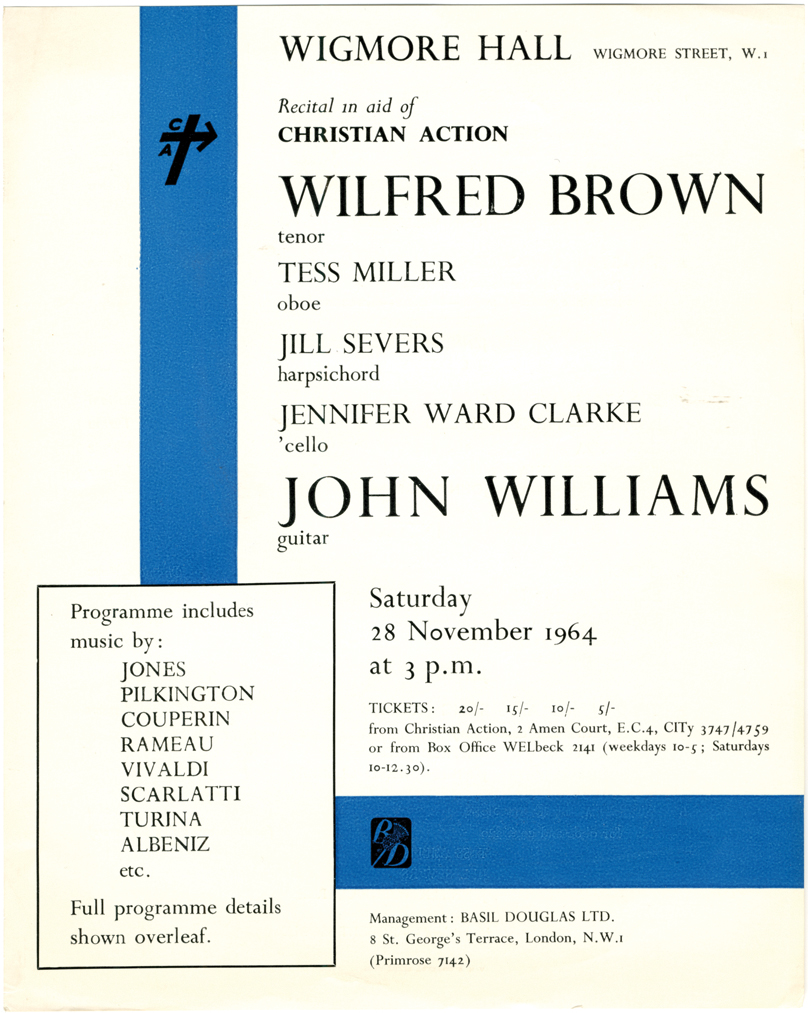
Poster for Wilfred Brown with The Boismortier Ensemble and John Williams, Wigmore Hall, 28 November 1964 (255 × 152 mm)
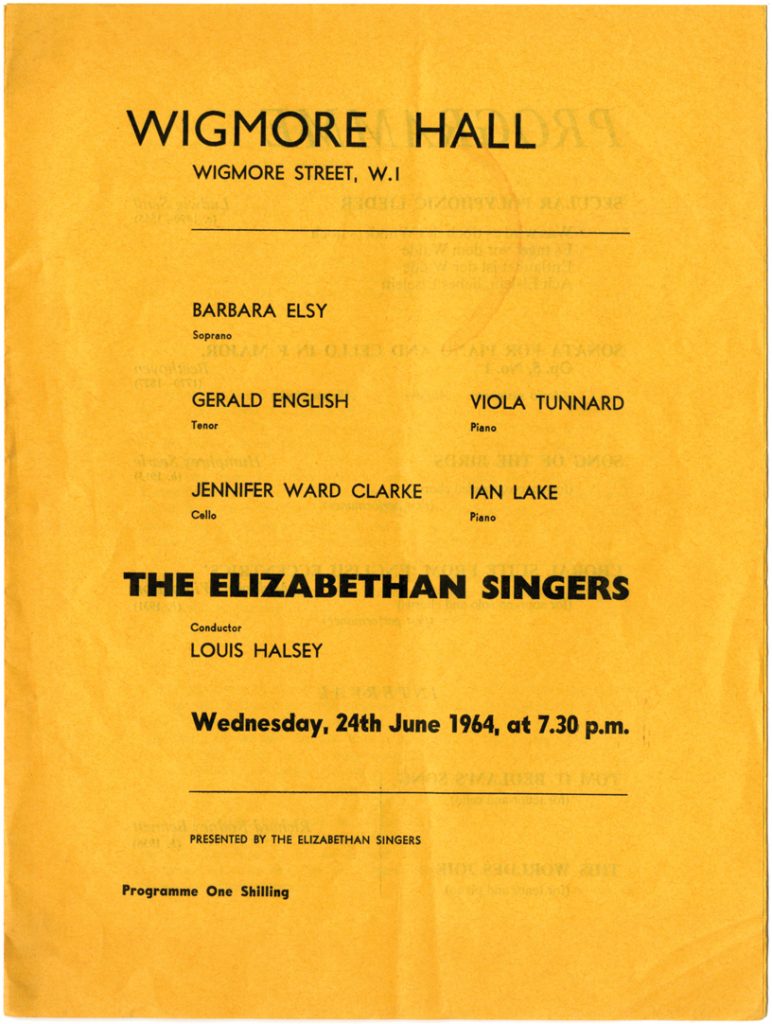
Programme cover for The Elizabethan Singers, Wigmore Hall, 24 June 1964 (253 × 190 mm)
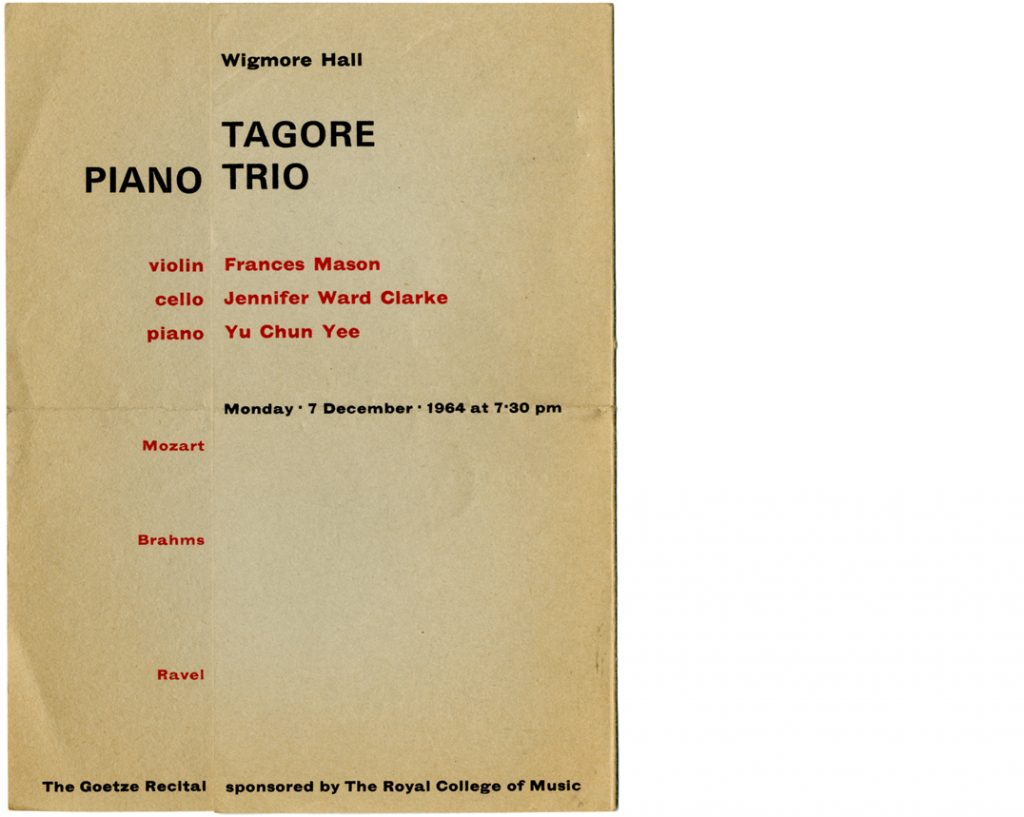
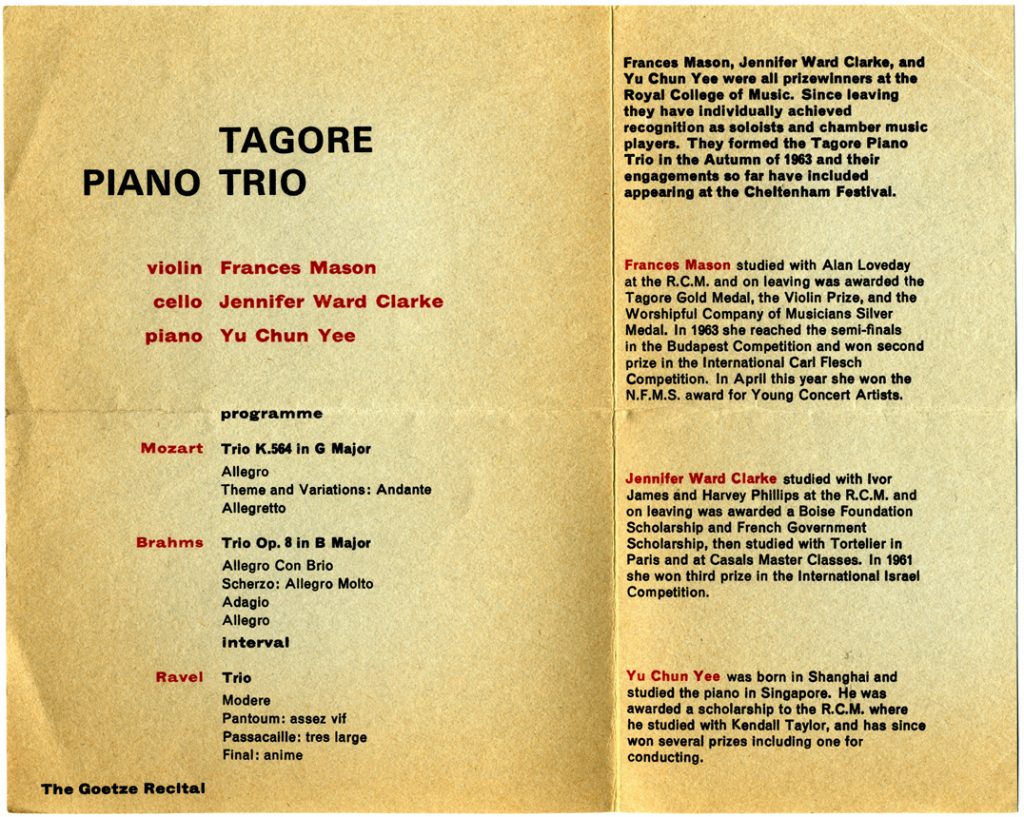
Programme for the Tagore Piano Trio, Wigmore Hall, 7 December 1964 (202 × 152 mm)
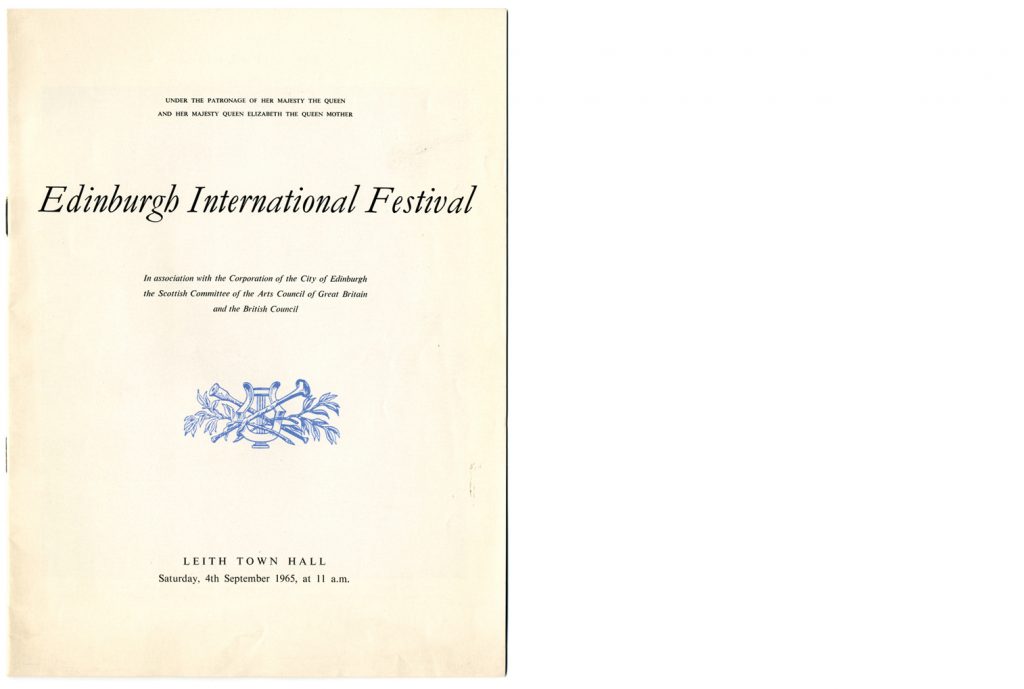
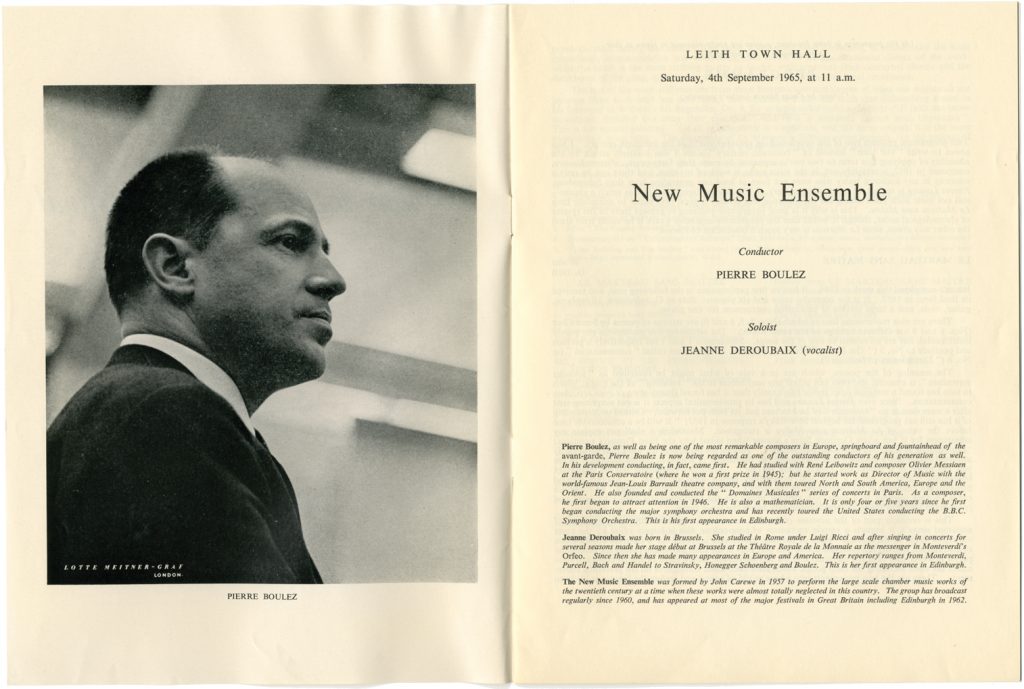
Programme for New Music Ensemble, Leith Town Hall, 4 September 1965: ‘Pierrot Lunaire’ and ‘Le Marteau sans Maître’ (246 × 185 mm)
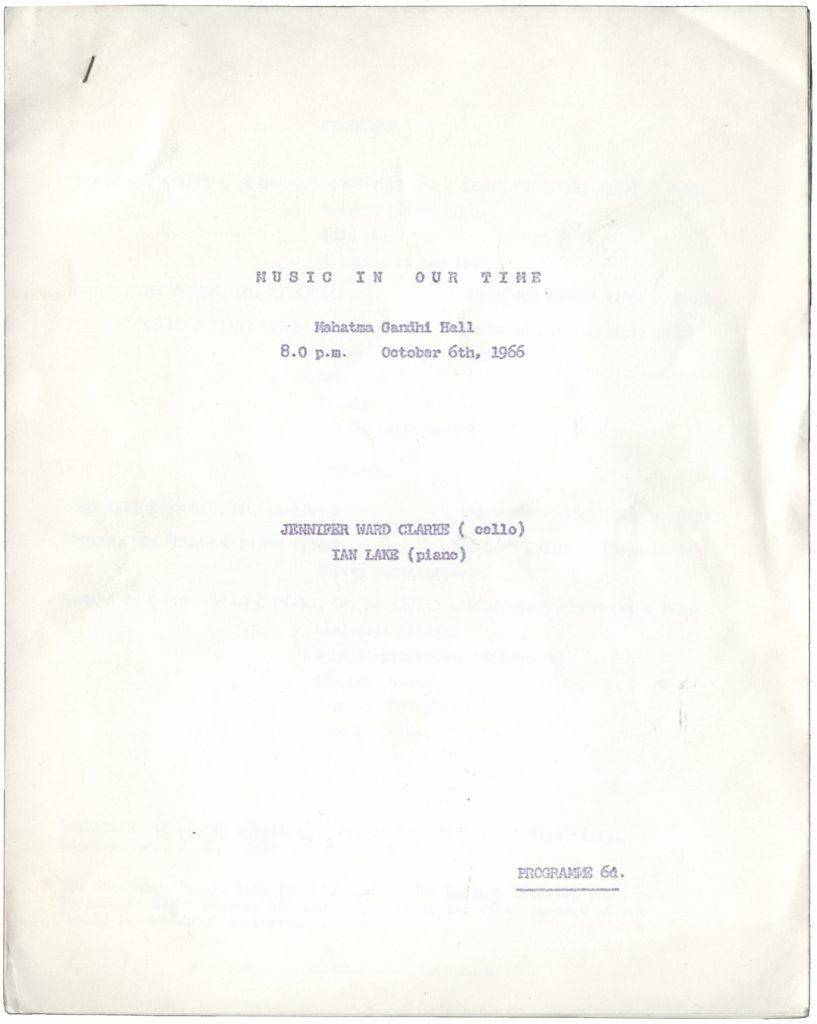
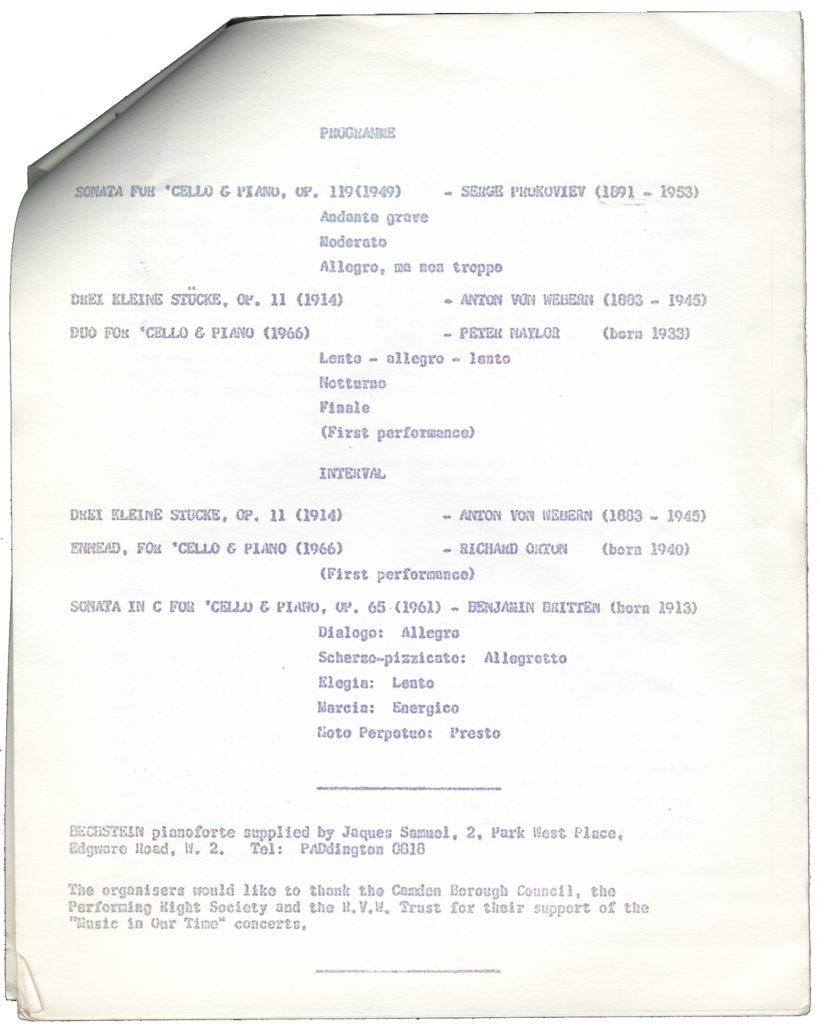
Programme for Ian Lake and JWC, ‘Music in Our Time’, Mahatma Gandhi Hall, 6 October 1966 (253 × 203 mm)
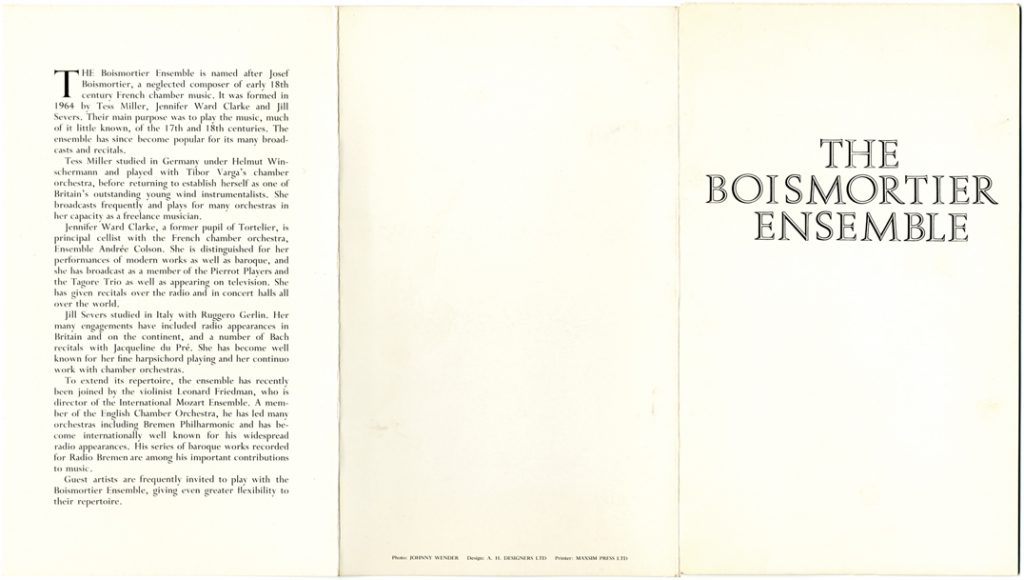
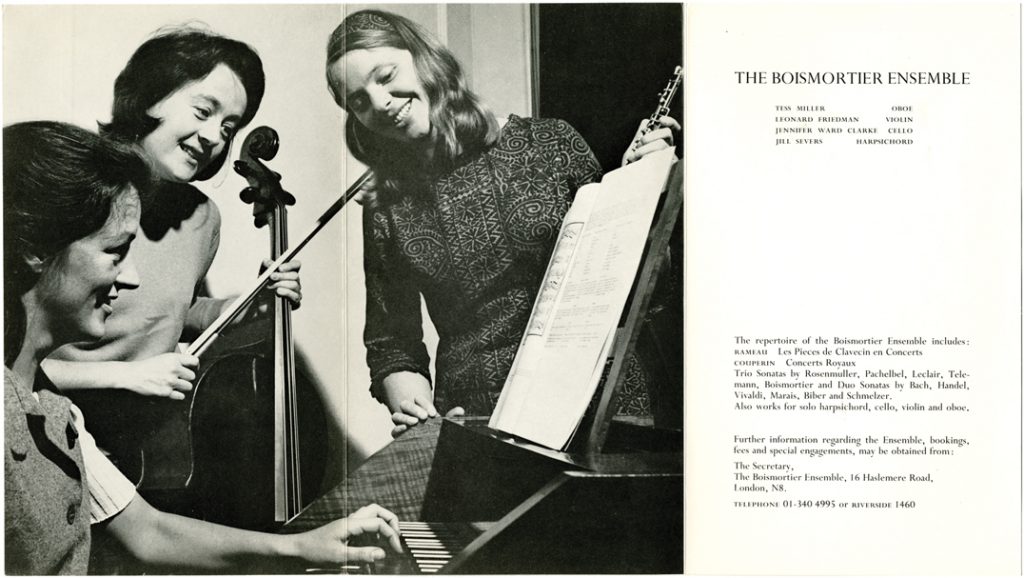
Front and back of a promotional leaflet for The Boismortier Ensemble (c. 1967) (256 × 455 mm)
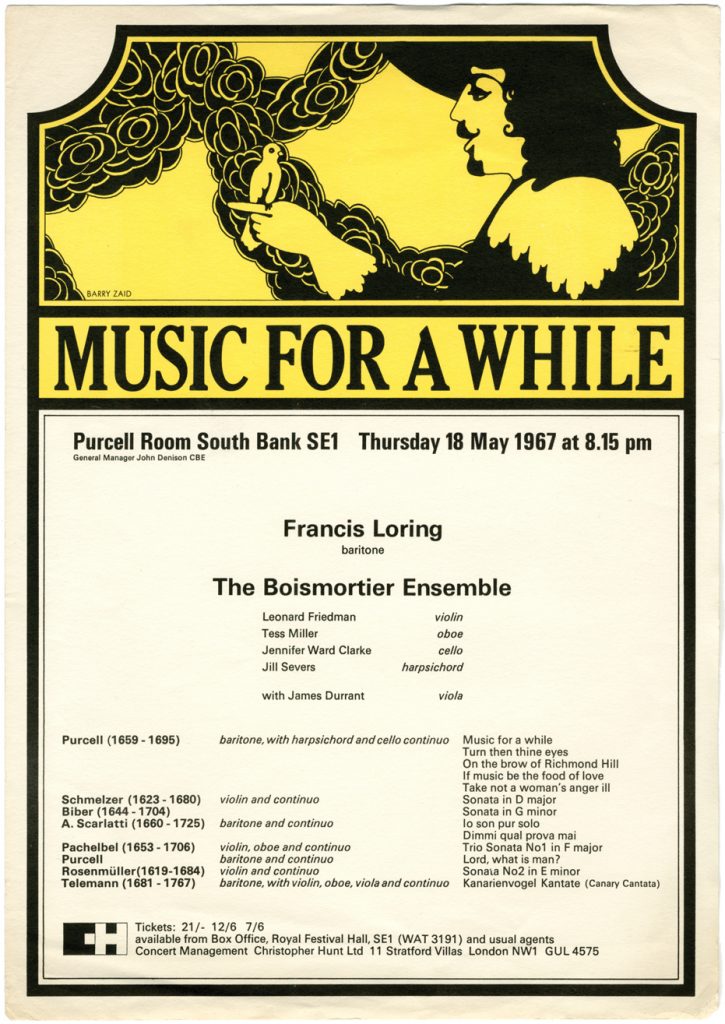
Poster for The Boismortier Ensemble, Purcell Room, 18 May 1967 (297 × 210 mm)
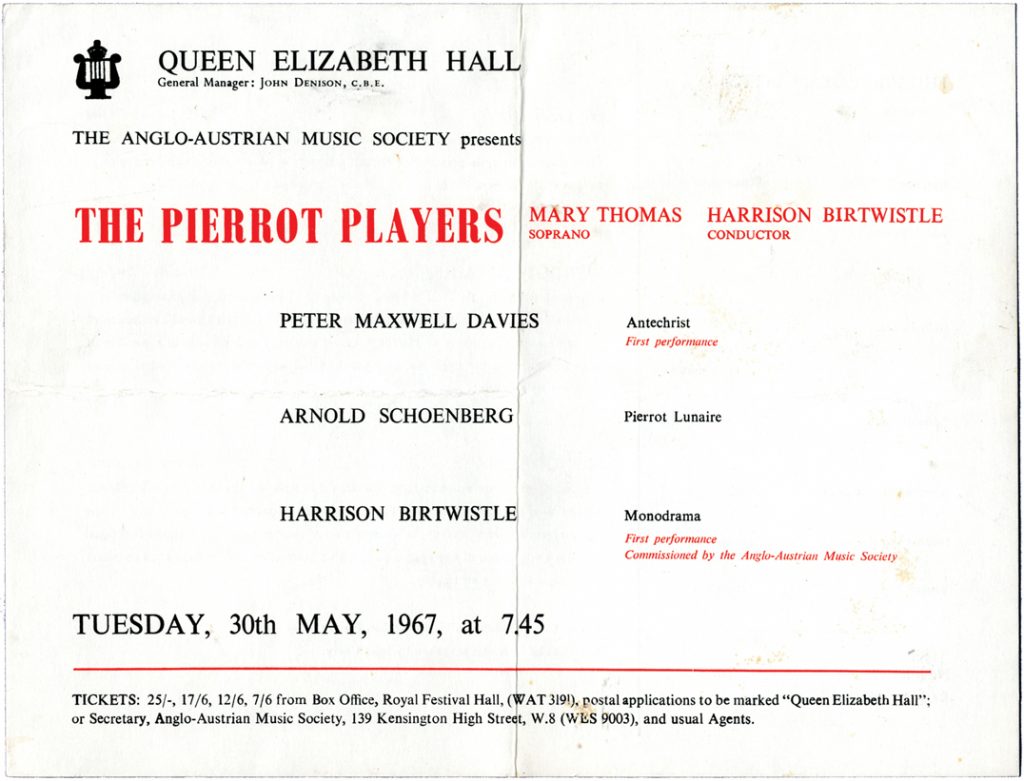
Poster for The Pierrot Players, Queen Elizabeth Hall, 30 May 1967 (188 × 247 mm)
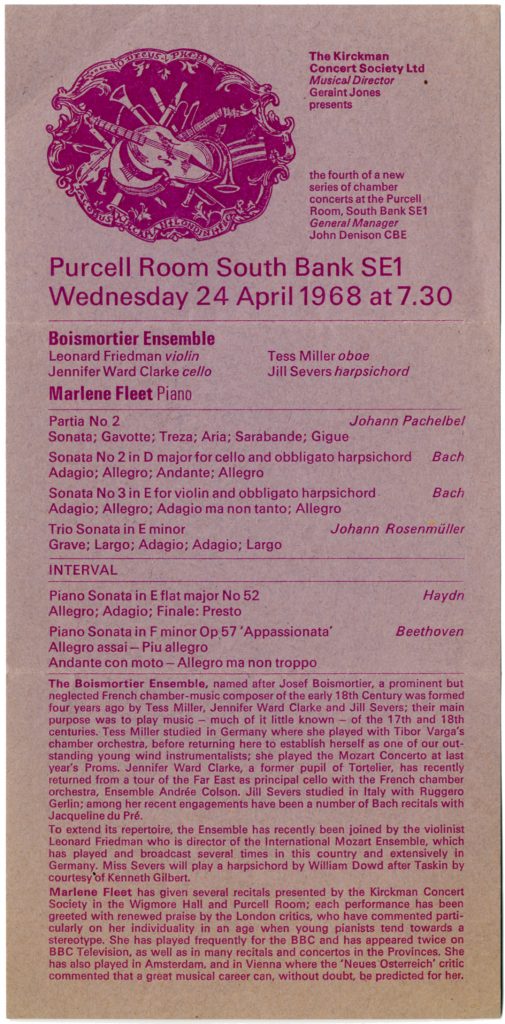
Programme sheet for The Boismortier Ensemble, Purcell Room, 24 April 1968 (207 × 100 mm)
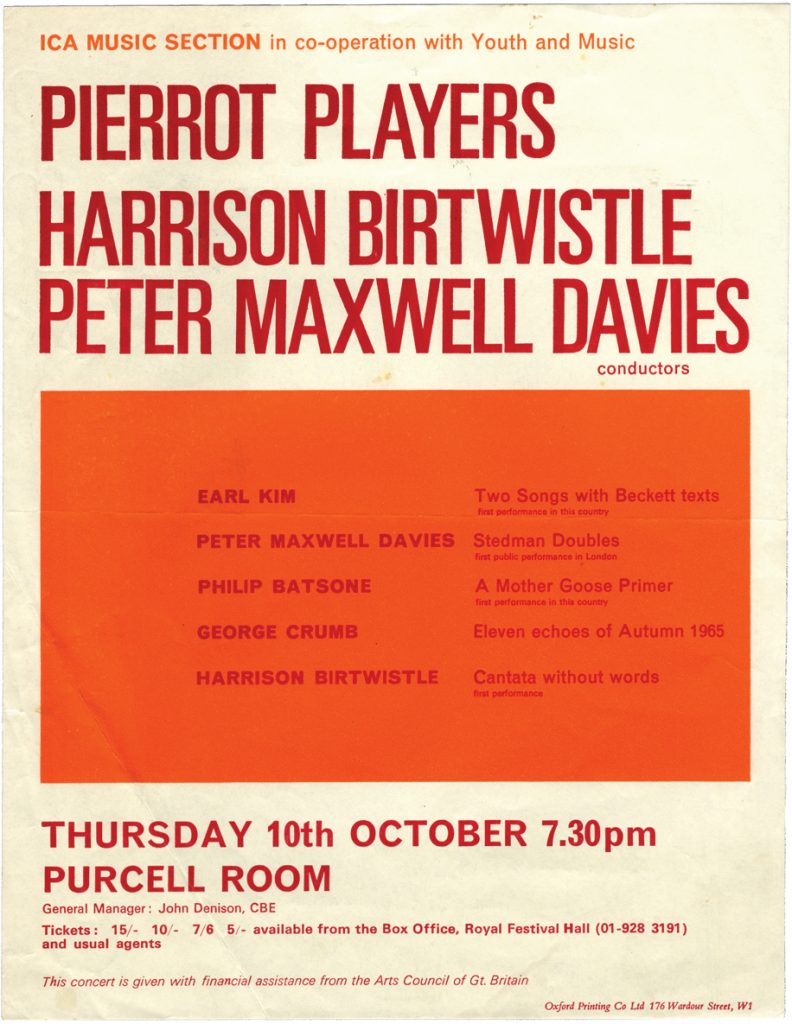
Poster for The Pierrot Players, Purcell Room, 10 October 1968 (263 × 204 mm)

Poster for The Fires of London, Queen Elizabeth Hall, 26 February 1969 (252 × 187 mm)
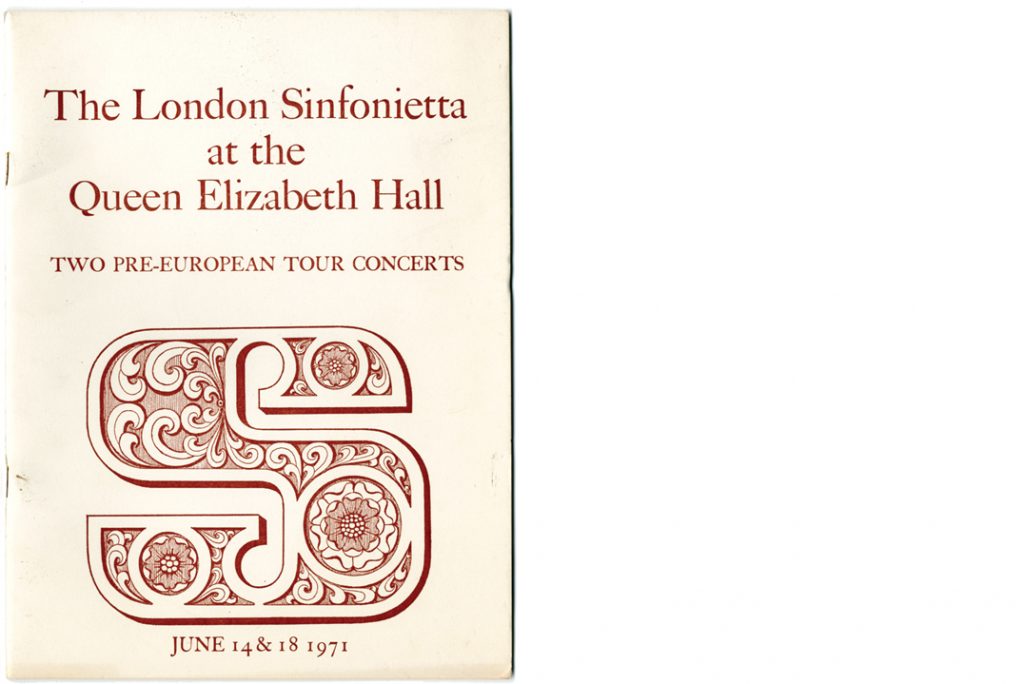
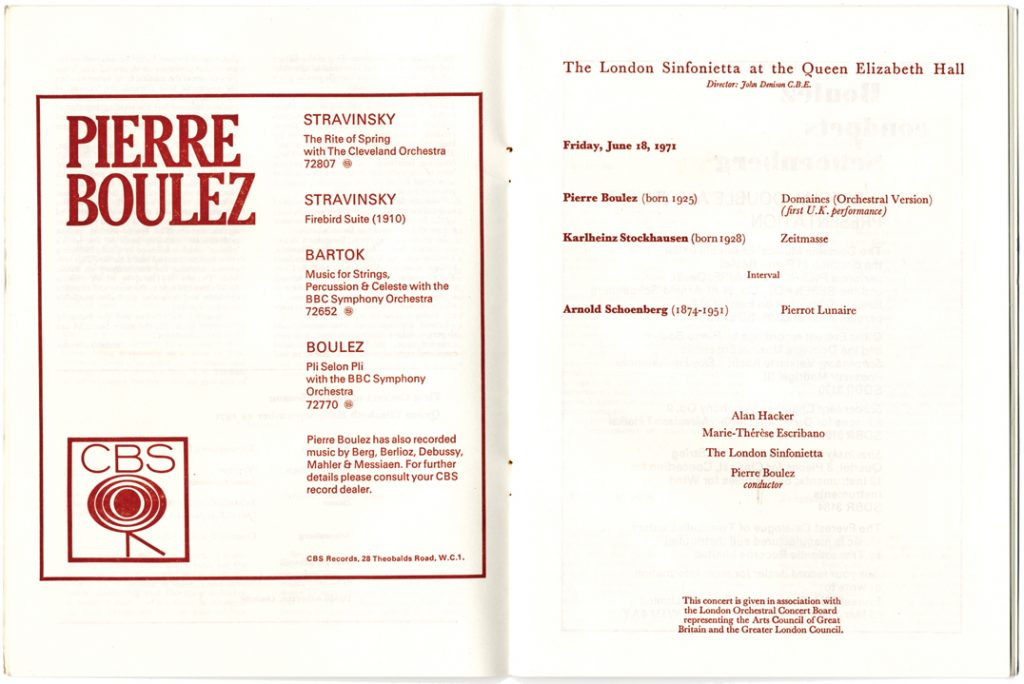
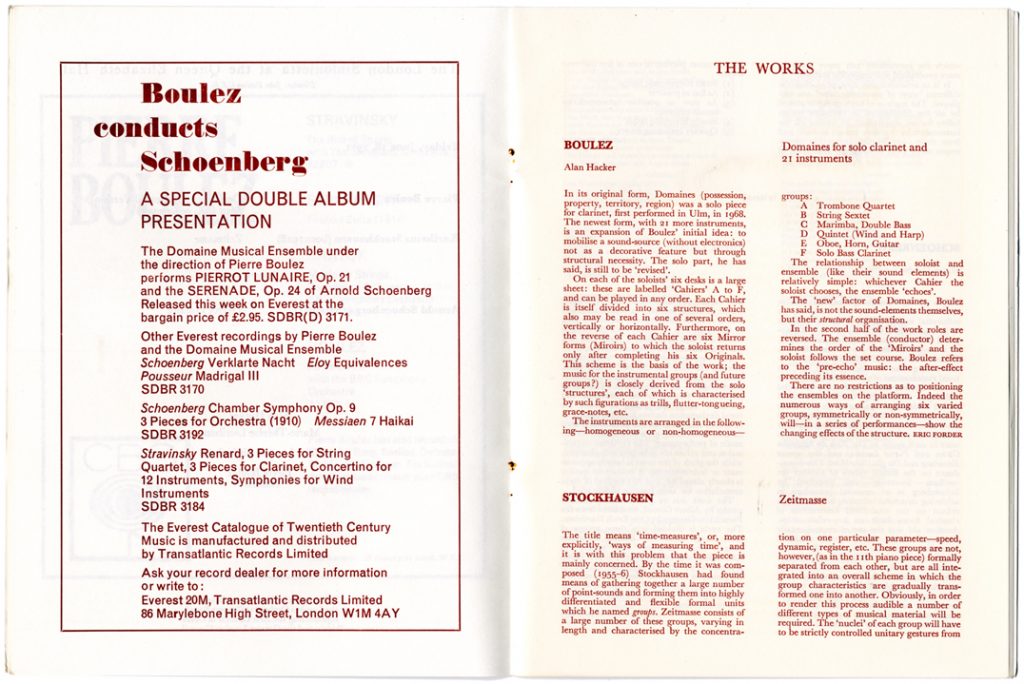
Programme for The London Sinfonietta, Queen Elizabeth Hall, 14 & 18 June 1971: Berio, Boulez, Stockhausen, Schoenberg (248 × 187 mm)
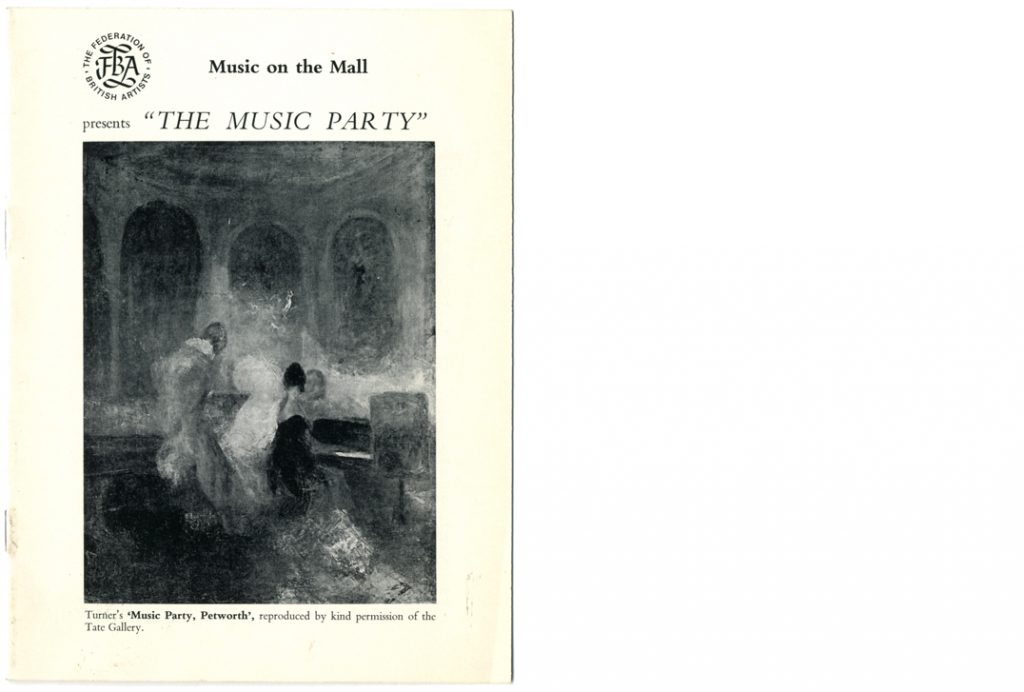
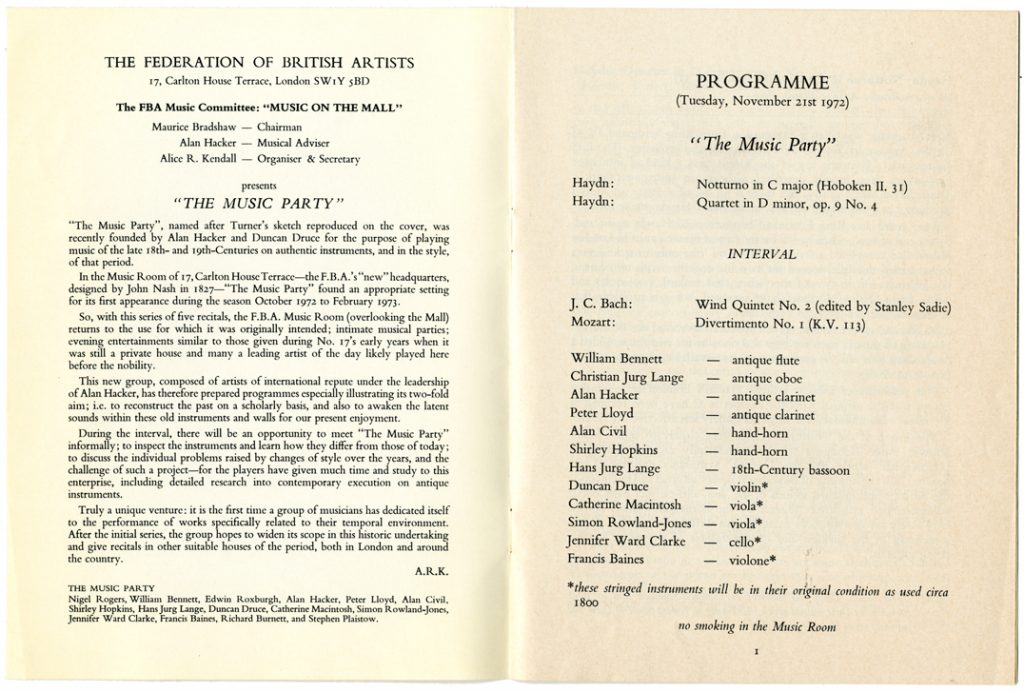
Programme for The Music Party, Music on the Mall, 21 November 1972 (194 × 146 mm)
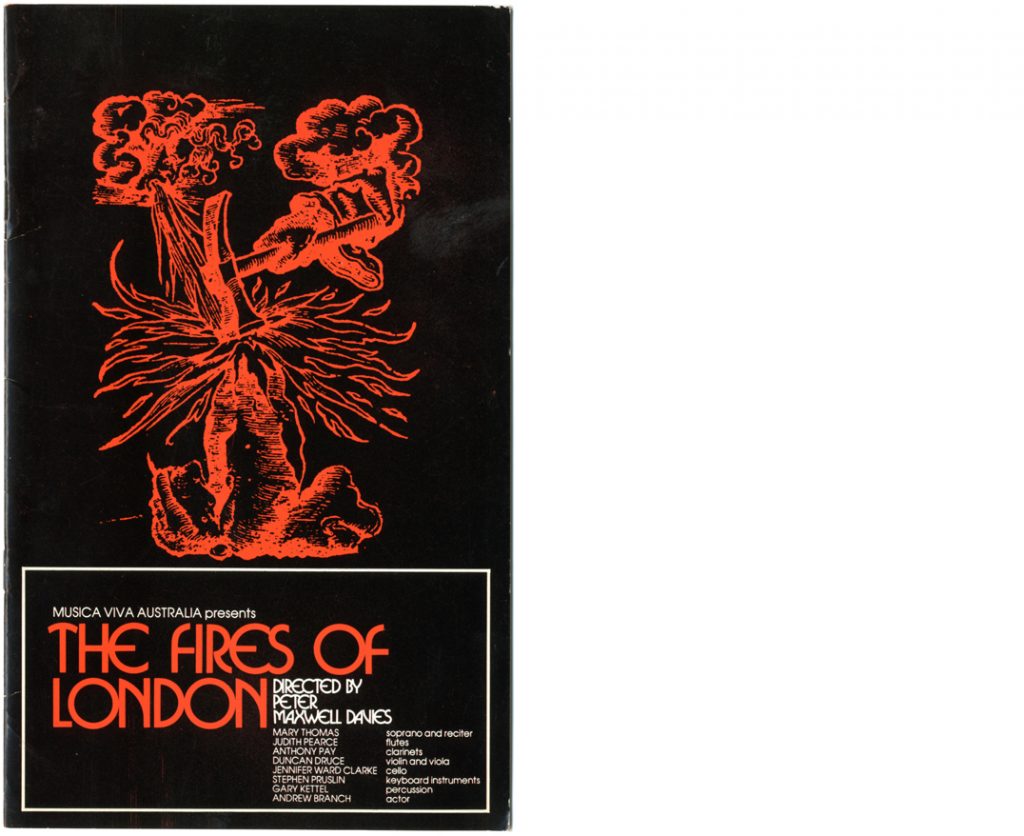
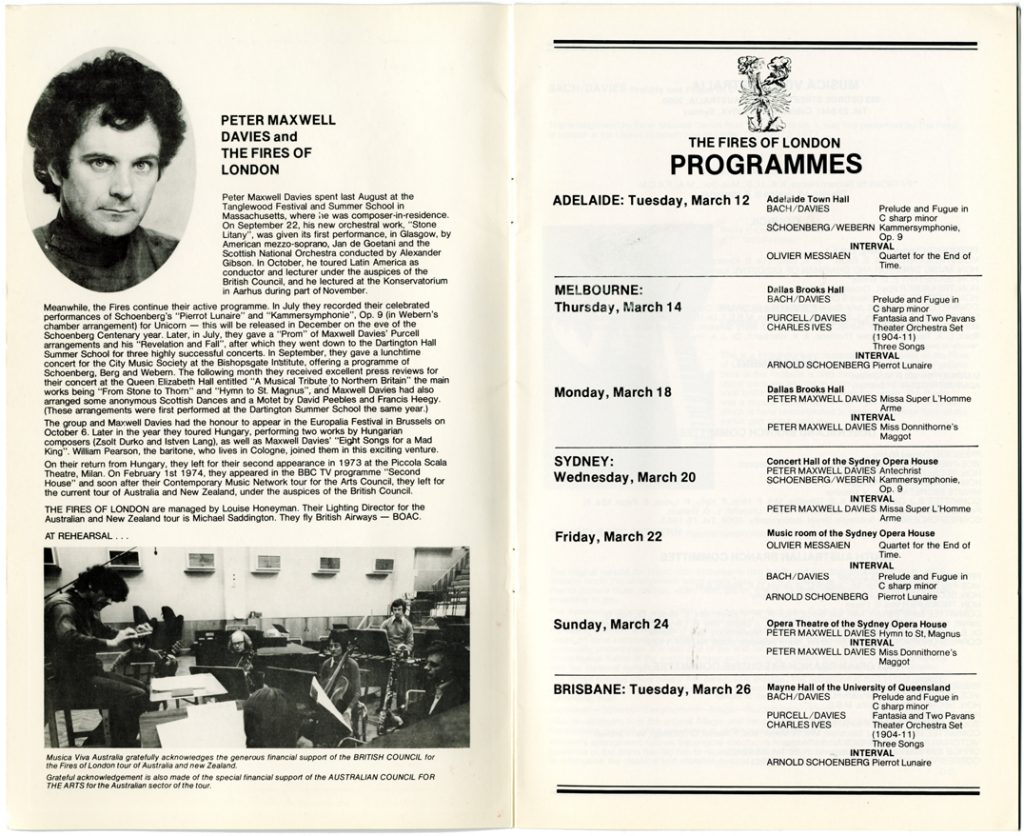
Programme booklet for The Fires of London Australian tour, March 1974 (248 × 152 mm)
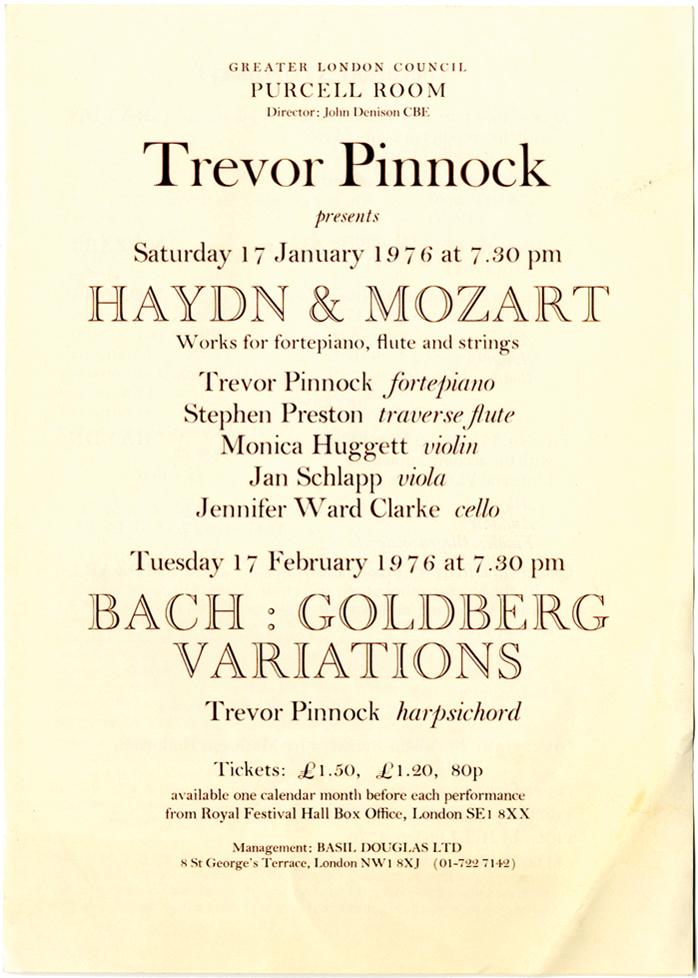
Leaflet cover for Trevor Pinnock and colleagues, 17 January & 17 February 1976 (210 × 150 mm)
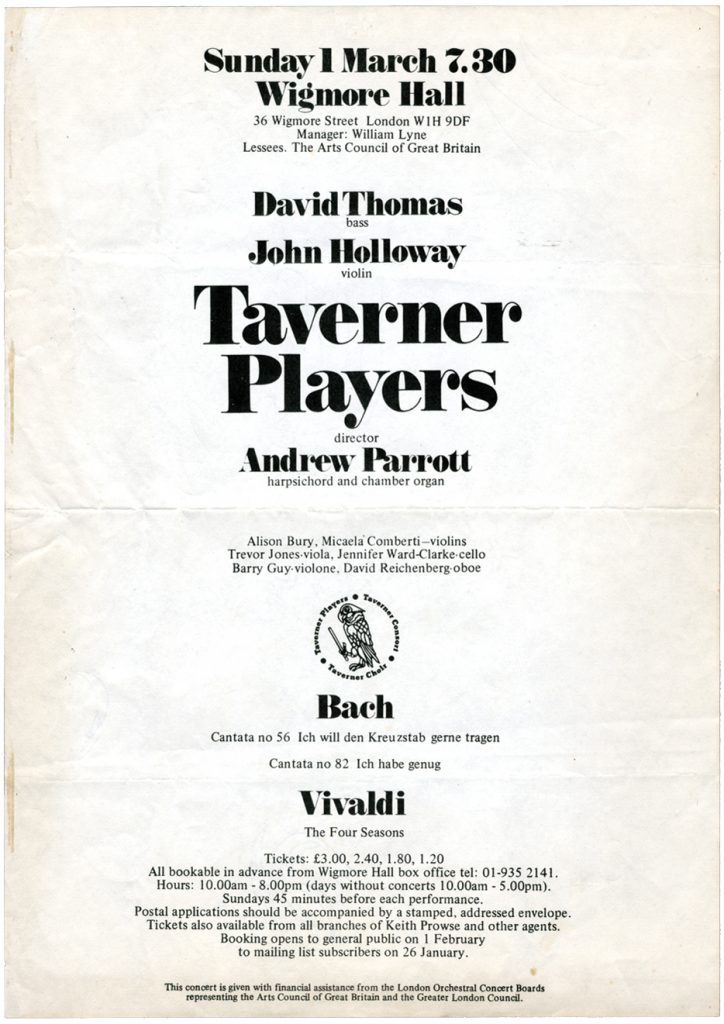
Poster for the Taverner Players, Wigmore Hall, 1 March 1981 (297 × 210 mm)
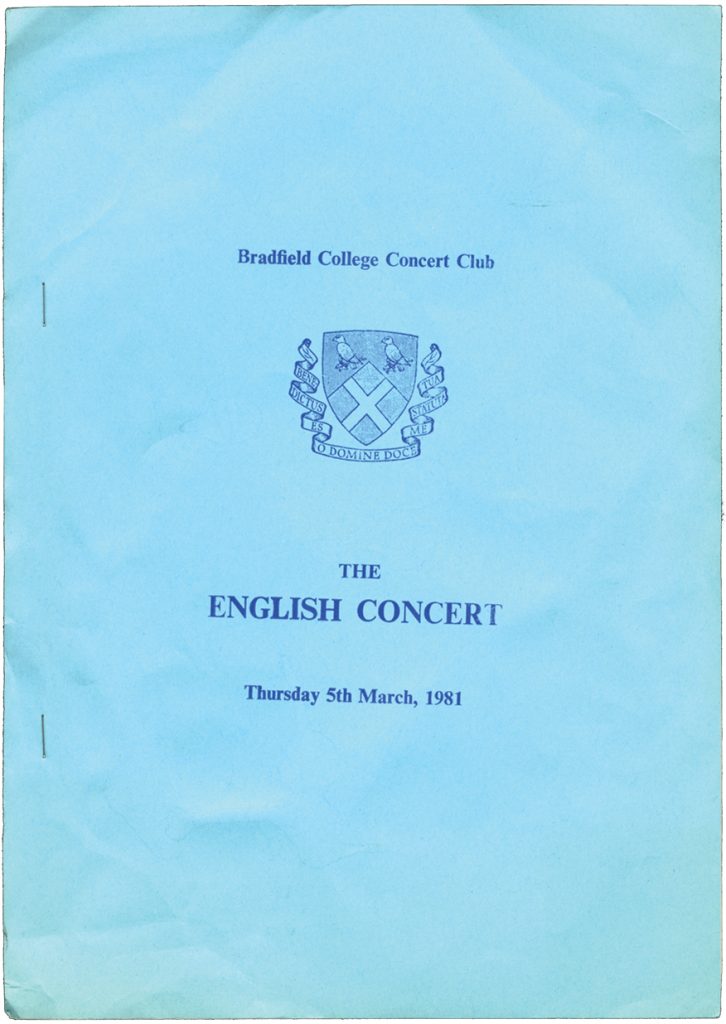
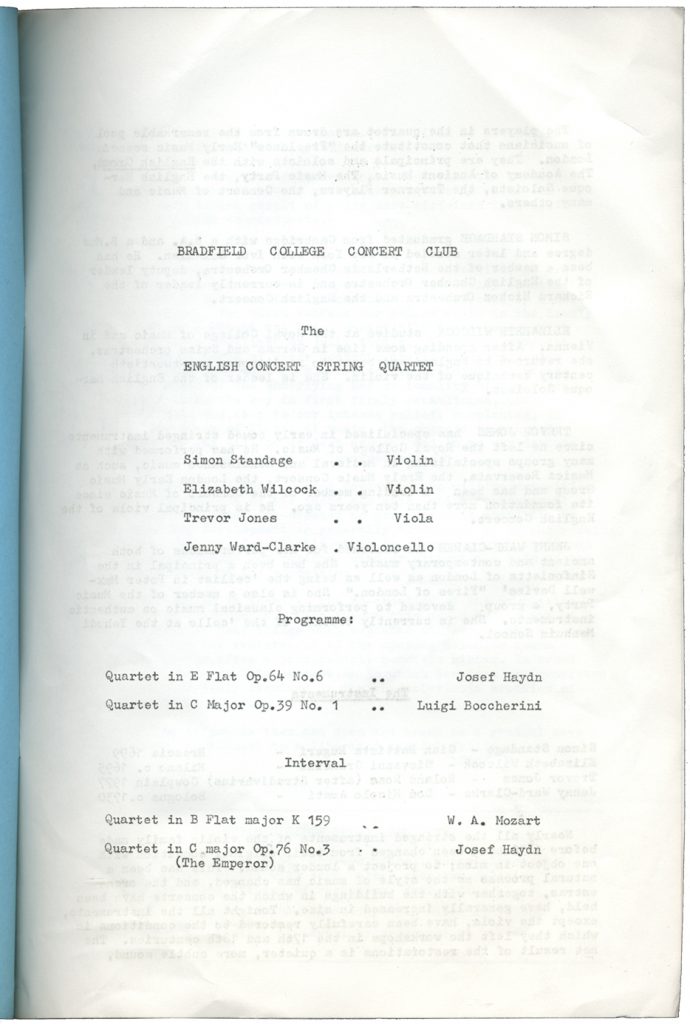

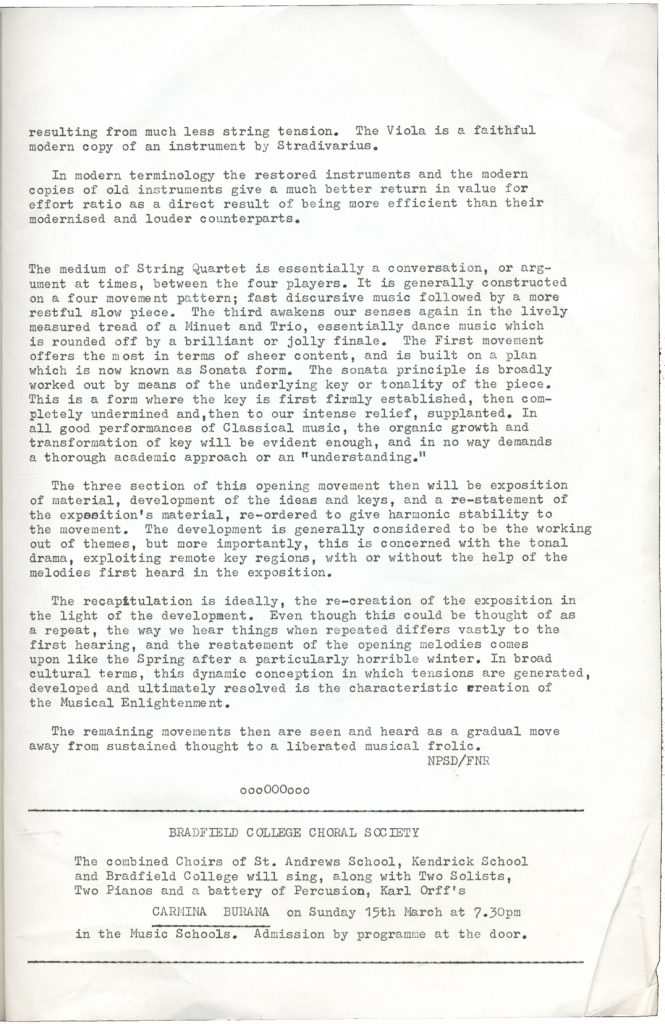
Programme for The English Concert String Quartet, Bradfield College, 5 March 1981 (297 × 210 mm)
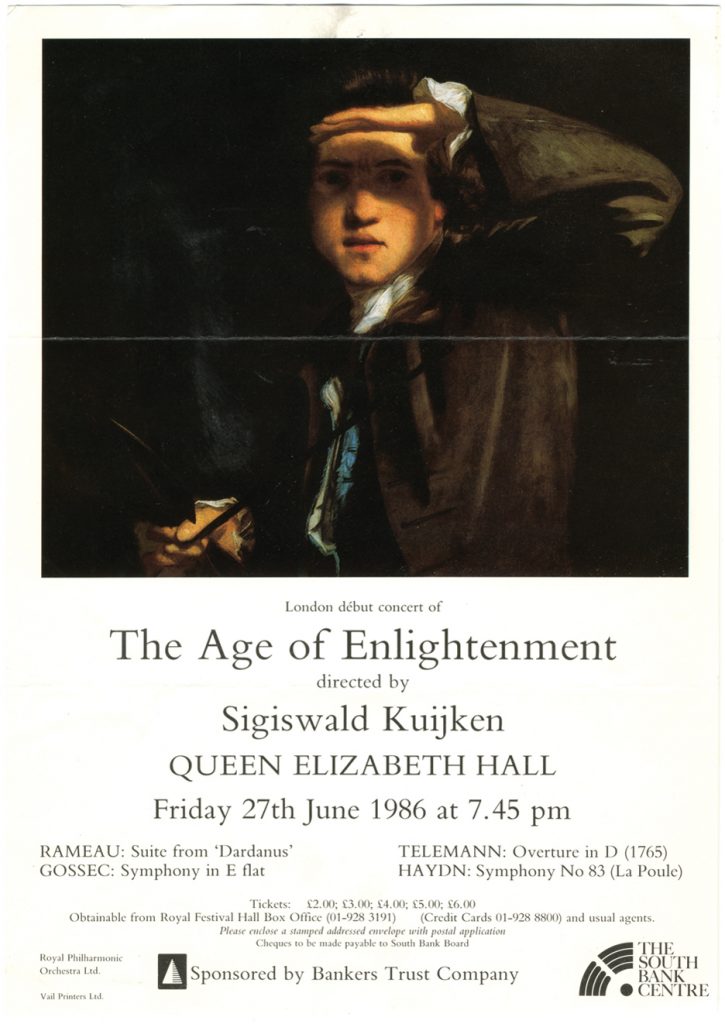
Poster for the Age of Enlightenment, Queen Elizabeth Hall, 27 June 1986 (297 × 210 mm)
Notes
- David Fallows in Grove Online writes that Musica Reservata ‘was founded in the mid-1950s by the writer and broadcaster Michael Morrow, the conductor and harpsichordist John Beckett, the recorder player John Sothcott and the countertenor Grayston Burgess, and was directed by Morrow. … [It] gave its first public concert at Fenton House, London, in 1960.’
J. M. Thomson described the first concert at the QEH: ‘Thus Musica Reservata was born, emerging into the full light of day at a memorable South Bank concert in the Queen Elizabeth Hall on Sunday 2 July 1967, an unforgettable occasion when we felt that early music had at last taken off in London. It opened with a rousing trumpet fanfare to Monteverdi’s Orfeo, continued with Italian composers, and in the second half covered secular vocal and instrumental music from 13th- and 14th-century France and early 16th century Spain. Jantina Noorman, his unconventional “star” singer, whom he described as “having an incredible sense of intonation”, had a riveting effect, if that is the right word. John Beckett conducted, Michael played chitarrone and lute, and among the other performers could be descried Grayston Burgess, Tom Sutcliffe, Nigel Rogers, David Munrow, John Sothcott, Desmond Dupre and, almost unbelievably, James Blades on percussion. I have never seen him look more ebullient.’ (J.M. Thomson, ‘Michael Morrow, 1929–94’, Early Music, vol. 22, no. 3, 1994, p. 537.) - ‘… there are too many that conservatively adhere to the comfortable and established orthodoxy, losing the sense of exploration, risktaking and discovery that is essential to the vitality of the music.’ (Trevor Pinnock, ’Reflections of a “pioneer” ’, Early Music, vol. 22, no. 1, 2013, pp. 17–21, at p. 19.)